Product Categories
SHOP BY ARTIST
NEWSLETTER
Navajo & Turquoise Jewelry
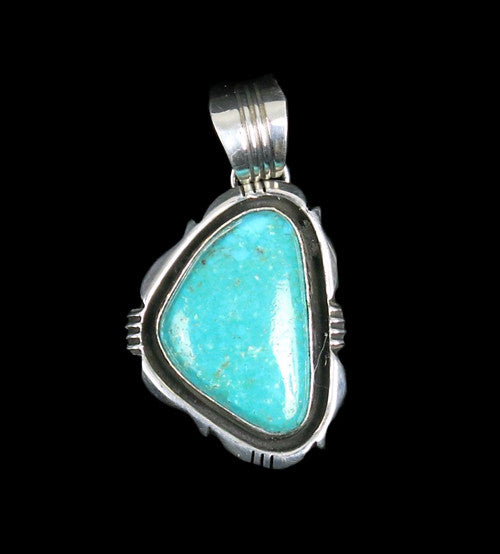
Kingman Turquoise and Sterling Silver Pendant by Will Denetdale (#280)
$265.00
Artist: Will Denetdale
Navajo silversmith Will Denetdale is one of the best and most productive artists working today. Will is in such demand because his jewelry is so clean and precise. The silver work Will wrapped around this natural high grade cabochon of Kingman, Arizona turquoise is superbly simple and elegant.
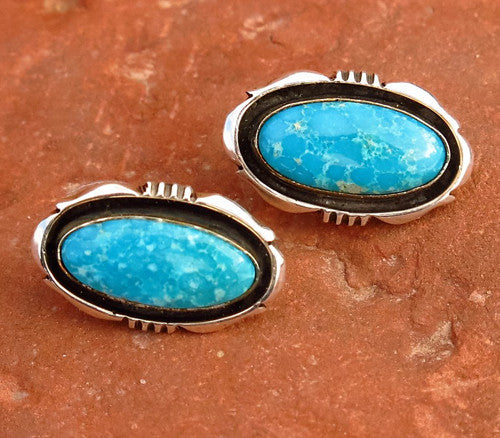
Searchlight Turquoise and Sterling Silver Post Earrings - Will Denetdale (#279)
$275.00
Artist: Will Denetdale
The Searchlight, Nevada turquoise mine has been around long enough to have had numerous owners and an equal number of names. The bottom line is that this turquoise is very fine. The matched pair of stones in these earrings came from the same specimen. The stones are completely natural and of a very high grade. Will Denetdale’s shadowbox settings were the perfect choice to highlight the Searchlight stones. This combination of sterling silver and sky stone makes for an exceptional set of earrings.
1" x 1 1/2"
See full biography Not on new site yet
See all items by Will Denetdale OK
Related categories:
Navajo Jewelry See all items in this category Not on new site yet (DELETE THIS??)
Add to Wish List (required login): Not on new site yet
Certificate of Authenticity Not on new site yet
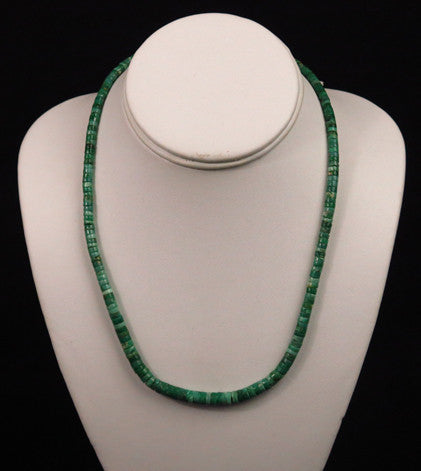
Broken Arrow Variscite Choker by Ray Lovato (#152)
$990.00
Artist: Ray Lovato
18 1/2"
Ray Lovato just drove in with a worn-out Dodge Caravan, six family members, three loaves of freshly baked Pueblo bread and a bag full of treasures. Within that saddle bag was a wonderful choker necklace of Broken Arrow Variscite. Ray said the material came from the Broken Arrow mine in Esmerelda County, Nevada. He met David Otteson, the mine owner, in Santa Fe, New Mexico and bought the rough material. Ray has the magic touch when it comes to turning raw material into a thing of beauty.
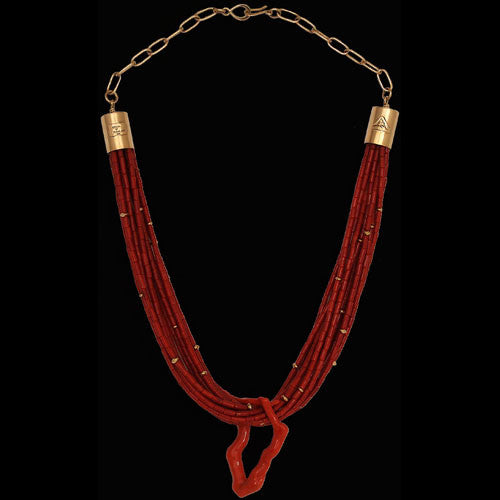
Navajo 13 Strand Coral & 14k Gold Necklace - Alfred Lee (#01)
$8,500.00
Artist: Alfred Lee
Navajo Jewelry
29" long
Navajo artist Alfred Lee has created an extraordinary necklace of Mediterranean coral and 14k gold. Alfred met an Italian family with ties to the old world while attending a jewelry show in Pasadena, California. The family just happened to have some of the best branch coral Alfred had ever seen, so he traded jewelry for it. Upon his return to New Mexico, Alfred began cutting and drilling the coral to make beads, matching pendent and accompanying gold work. This necklace is the result of that trade and creative process. Superb!
We offer a 100% satisfaction guarantee on every purchase.
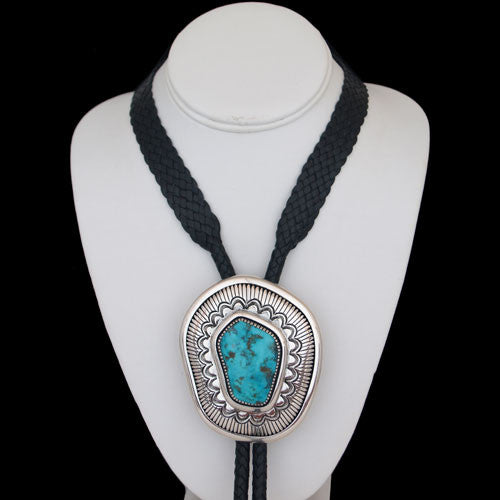
Navajo High Grade Morenci Turquoise Bolo Tie - Allison Lee (#196)
$3,750.00
Artist: Allison Lee
Bolo: 2 3/4" x 3 1/4"
Strap: 50"
Allison Snowhawk Lee has taken a wonderful piece of gem-grade Morenci turquoise and mounted it in one of his classically beautiful hand-fabricated, sterling silver settings. Allison is the most refined finish artist we know, and one of the best all around silversmiths. Who better to set a remarkable stone than a remarkable artist? Beauty, rarity and durability are the three attributes that distinguish a quality, collectible piece of art. All three are definitely present with this amazing bolo tie.
Morenci Turquoise
Morenci Turquoise; Arizona Mine, Morenci, Clifton-Morenci District, Shannon Mountains, Greenlee County, Arizona, USA. An open pit copper mine located in the N1⁄2 Section 16, T4S, R29E (Clifton 15 minute topographic map), owned by Phelps Dodge Corp. Map Reference: 33°5'26"N, 109°21'58"W.
Morenci turquoise was mined in southeastern Arizona until approximately 1990. It is located very near the New Mexico border, and ranges in color from classic high electric blue to light azure. Prehistoric Indians who valued the stone for its deep blue color were the first to discover the deposit. These people adorned themselves with rough-hewn beads and carved talisman made from the mineral
Morenci is often associated with an unusual black matrix of irregular iron pyrite, which looks metallic when polished. Although they are rare, stones with unusual birds-eye patterns, red matrix and an occasional layer of silver have also been found. The Morenci name is derived from the large open pit copper mine owned and operated by the Phelps Dodge Corporation. Early examples of this striking turquoise were of the "lunch box" variety, meaning workers and miners carried them out of the mine.
Morenci is well known; it was one of the first types of American turquoise to find its way to the market and is always difficult to obtain because the mine was depleted so long ago. It is believed that the best Morenci ever produced was discovered in the late 1960's to early 70's. During this time period, the mine produced a high, electric blue variety with iron pyrite inclusions. Since Morenci is no longer being mined, and because of its striking color and unusual matrix combinations, high grade natural Morenci is a valuable, highly collectible mineral.
USGS; Arizona.--In Arizona turquoise ranks first in terms of value of production and is also the best known of its gem materials. Nearly all-important deposits of turquoise are located near copper occurrences or in copper deposits in arid desert regions of the world. Thus, the world famous turquoise deposits associated with certain of the large Arizona copper deposits are to be expected.
Turquoise is, or has been, mined from a number of these copper mines as a byproduct, usually by outside contractors. The financial and operating terms of the collecting contracts vary from mine to mine. Some of the operations are little more than the efforts of individual commercial collectors; some are essentially full-scale mining operations that are simultaneous with, but separate from, the regular mining operations; and still others operate on an on-call basis as turquoise is uncovered by the regular copper mining operation. Regardless of the size or sophistication of the initial mining or recovery operation, the actual turquoise is recovered by careful extraction using hand method.
About the artist:

Allison Lee - Navajo Silversmith:
Speaking of the silver and gold jewelry he hand crafts, Allison Lee's captivating voice is sincere when he says, "One time my uncle told me that everything we build comes from the earth, like the silver that comes from the earth, or the turquoise that comes from the earth. That is a lot of energy. You put it together and you put your heart and mind into a piece. Then sometimes a certain piece of jewelry- I believe- it is made for a certain person. I usually have a ring, or something, that stays with me for about two or three years, until the right person comes along. And then that person buys that piece. I believe that every piece of jewelry that I make is made for somebody out there- it's made for somebody special. Whoever might be having problems, or something like that. In essence, that energy helps that person get help, by wearing pieces that we make. That is the way I look at it.
Related legends:
Silversmith Work
When and how the Navajo acquired the art of working metals is unknown but there are reasons for supposing that it was introduced among them, or at least more developed and improved upon by them, since the time they have occupied their present country?
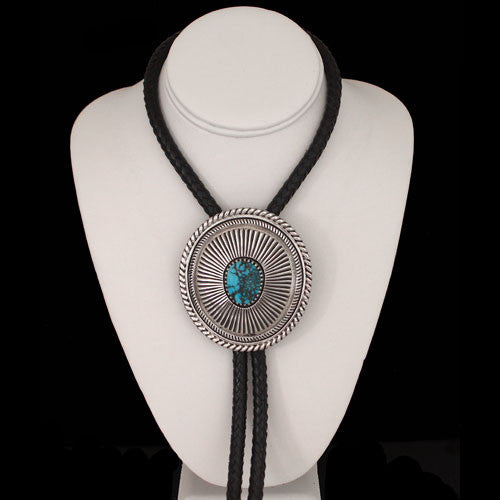
Navajo Pilot Mountain Turquoise 22.15 ct Bolo Tie - Allison Lee (#177)
$3,500.00
Artist: Allison Lee
Navajo Jewelry
Bolo: 2 3/4" x 3"
Strap: 46" long
Allison Lee, great stamping, exquisite execution, Pilot Mountain turquoise, sterling silver! What can we say? Oh yea, great price.
We offer a 100% satisfaction guarantee on every purchase.
About the artist:

Allison Lee - Navajo Silversmith:
Speaking of the silver and gold jewelry he hand crafts, Allison Lee's captivating voice is sincere when he says, "One time my uncle told me that everything we build comes from the earth, like the silver that comes from the earth, or the turquoise that comes from the earth. That is a lot of energy. You put it together and you put your heart and mind into a piece. Then sometimes a certain piece of jewelry- I believe- it is made for a certain person. I usually have a ring, or something, that stays with me for about two or three years, until the right person comes along. And then that person buys that piece. I believe that every piece of jewelry that I make is made for somebody out there- it's made for somebody special. Whoever might be having problems, or something like that. In essence, that energy helps that person get help, by wearing pieces that we make. That is the way I look at it.
Related legends:
Silversmith Work
When and how the Navajo acquired the art of working metals is unknown but there are reasons for supposing that it was introduced among them, or at least more developed and improved upon by them, since the time they have occupied their present country?
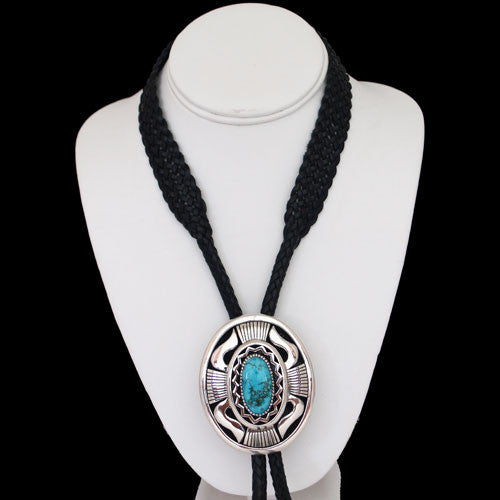
Navajo Natural High Gem Grade Blue Gem Turquoise Bolo Tie - Allison Lee (#191)
$3,200.00
Artist: Allison Lee
Bolo: 2 3/8" x 2 7/8"
Stone: .58" x 1.22"
Strap: 44"
Allison Lee is surely one of the most talented silversmiths we have ever run into. When you connect him with turquoise from Barry’s private reserve; well, the result is, as you see, SPECTACULAR. Sorry for shouting, but this oval piece of high-grade Blue Gem fits right into Allison’s carved and stamped Ketoh design. It is a rare individual who can fabricate bolo ties of this quality. Both Allison and his jewelry are extraordinary.
Blue Gem Turquoise
Blue Gem turquoise occurs in argillized quartz monzonite cut by two limonite-stained sheer zones, one trending N 35 o W and dipping 75 o NE, the other trending N, 25 o E and dipping 55 o NW. An extensive breccia zone about 10 feet wide is developed between the two bounding sheers. Exceptionally good quality turquoise forms veins up to three-quarters of an inch thick along the shears. Pyrite-bearing quartz veins are closely associated with the turquoise.
The Blue Gem mine was at one time located deep underground, accessed by tunnels as deep as 800 feet. This is of interest because the Blue Gem Mine and the Bisbee Mine in Arizona are the only two mines (of which we are aware) that turquoise was found that deep in the earth. The Blue Gem mine was once developed in extensive underground workings and open stoops. An audit several hundred feet long on the main structure connected to numerous shorter tunnels and several open stoops. Directly above the main audit was a glory hole some 100 feet long.
Duke Goff first noted the Blue Gem deposit in 1934. It was subsequently leased from the Copper Canyon Mining Co. by the American Gem Co. of San Gabriel, CA., owned by Doc Wilson and his sons, Del and William. The company operated the property until 1941 when the outbreak of the war caused a shortage of experienced miners. Both Del and William Wilson were called into the Army for the duration of the war, and this compelled the closing of the mine. Consequently, the lease was allowed to lapse and work was abandoned. In 1950 Lee Hand and Alvin Layton of Battle Mountain leased the mine.
Production of turquoise at the Blue Gem lease in the early days of the operation was enormous. Although there is no exact information, it is reported that the output amounted to nearly
$1 million in rough turquoise. The mine is still active, although Duval Corp is currently in the center of a major copper deposit developing it.
Pyrite in Blue Gem is unusual to see but not unheard of. Very little large material ever came out of Blue Gem, the majority found was small 1-mm "bleeder" veins and tiny nuggets which was perfect for Zuni inlay and fine needlepoint, petit-point and snake-eyes jewelry. Blue Gem turquoise was very popular in the late 1930's and 40's and was commonly used in the Fred Harvey "tourist jewelry" that is so collectable today. Blue Gem turquoise is extremely hard and stands up well to the test of time.
Blue Gem turquoise is a rare, valuable and historic American treasure. Quality Blue Gem Turquoise has been gifted with a wide range and variety of color. Because Blue Gem turquoise is very hard, a high polish is associated with this stone, and unlike most turquoise, won't easily change color. This turquoise has a unique character and many different looks all of which are striking, full of wonder and pleasing to the eye.
Production of the mine started about 1934 and continued into the 1970's. Blue Gem Turquoise is still some of the finest turquoise ever found, and unlike most turquoise mines, (in which the majority mined is chalky and only usable if stabilized) most of the turquoise found there was of gem-quality. Today the Blue Gem mine is not viable; it sits in the middle of a huge mining operation. The emphasis is on precious metals and the extraction of turquoise is considered more of a hindrance in the mining process rather than an asset. Even the ever-popular "Dump Diving" for turquoise through the overburden is not tolerated due to the very real danger of becoming buried in a slide. Insurance factors, equipment hazards, high explosives and safety issues along with a lack of interest from the mining company keep Blue Gem turquoise unavailable to the world, at least for now.
About the artist:

Allison Lee - Navajo Silversmith:
Speaking of the silver and gold jewelry he hand crafts, Allison Lee's captivating voice is sincere when he says, "One time my uncle told me that everything we build comes from the earth, like the silver that comes from the earth, or the turquoise that comes from the earth. That is a lot of energy. You put it together and you put your heart and mind into a piece. Then sometimes a certain piece of jewelry- I believe- it is made for a certain person. I usually have a ring, or something, that stays with me for about two or three years, until the right person comes along. And then that person buys that piece. I believe that every piece of jewelry that I make is made for somebody out there- it's made for somebody special. Whoever might be having problems, or something like that. In essence, that energy helps that person get help, by wearing pieces that we make. That is the way I look at it.
Related legends:
Precious Stones
Turquoise; Precious stones have symbolic implications. For example, turquoise if a "collective term for all the precious stones, wealth, or mixed offerings. Good fortune is attributed to this stone." Both white shell and turquoise are emphasized in Kinaalda? More about this legend
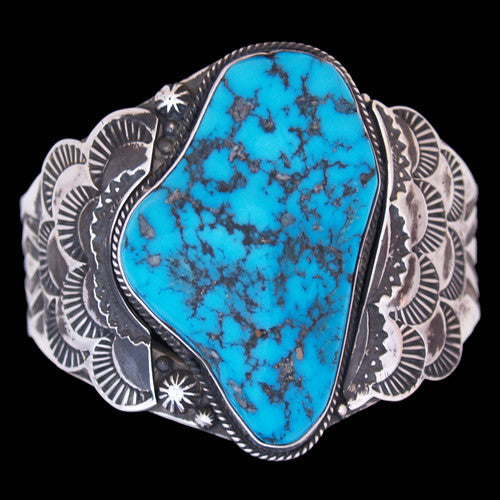
Navajo Castle Dome Turquoise Bracelet - Eugune Livingston (#128)
$3,200.00
Artist: Eugune Livingston
ATC
Navajo Jewelry
Castle Dome Turquoise Bracelet
Size: 6 1/2
In his latest work, Eugene Livingston has revived a 1940s jewelry design, added his own twist of creativity and crafted a very nice wrist cuff. Eugene starts with sterling silver shot, heats it until molten and pours it into a bar. He then puts the bar through a heavy duty roller and mills it to the desired thickness. Using this process he makes his own silver sheet and wire in order to create his unique jewelry pieces. The solidity and strength of Eugene's jewelry allows it to wear better and last longer. This bracelet is set with a high grade, natural cabochon of Castle Dome turquoise from Globe, Arizona.
We offer a 100% satisfaction guarantee on every purchase.
Castle Dome Turquoise
Castle Dome turquoise is derived from the Globe-Miami mining district, Gila County, Arizona, five miles west of Miami. The Castle Dome open-pit copper mine, rests on the south slope of Porphyry Mountain.
Castle Dome Turquoise, CuO·3Al2O3·P2O5·H2O.--is fairly widespread throughout the chalcocite zone and in the leached capping. A hard variety of gem quality occurs in small veinlets up to one-quarter inch thick and also in concretion-like masses up to one-half inch thick and several inches across. Its color ranges from sky-blue to bluish-green, the blue variety predominating. It is generally associated with clay minerals and sericite which form selvages on the veins and masses and are commonly included in the turquoise. Seen under the microscope; it it is a microcrystalline aggregate having a mean index of refraction of 1.62.
A few specimens of a light-green, iron-bearing copper aluminum phosphate were found occurring in the same manner as the hard blue turquoise. It is a microcrystalline aggregate whose mean index of refraction is 1.67. Charles Milton of the Geological Survey identified the mineral as a ferrian turquoise. He reports as follows:
Employees of the mine have been permitted to dig turquoise on days when they were not on duty, and an amazingly large quantity of the mineral has been purchased by dealers in Globe and Miami. Unfortunately no record is available as to the amount of turquoise produced, but undoubtedly the Castle Dome mine is one of the most important sources of gem turquoise at the present time.
Turquoise is generally conceded to be a supergene mineral, formed by the action of ground-water solutions, carrying copper and phosphate ions, on kaolin and possibly sericite. Various writers describe all stages in the alteration from copper-stained kaolin to hard blue turquoise; but it is not usually clear from the published descriptions whether the mineral is kaolinite or some other clay. Kaolinite is not a common mineral in the Castle Dome deposit, and its association with turquoise has not been noted; however, turquoise is commonly associated with beidellite, halloysite, and sericite. No evidence has yet been found suggesting that it forms from clay. The hard blue turquoise grades into the soft, white clay-like variety; but the index of refraction of all of it is near 1.62, which is much higher than that of any of the clays present. None of the material could be construed as being transitional between turquoise and the associated clay.
Although turquoise is most abundant in the upper part of the secondary sulfide zone, it is commonly found in deep fractures where chalcopyrite is only slightly replaced by chalcocite or not at all. If turquoise was formed by supergene solutions, the phosphate ion would have to be derived from either wavellite or apatite which are the only earlier phosphate minerals. Wavellite is apparently dissolved by supergene solutions, but much turquoise occurs in parts of the mine where no wavellite has been recognized. In the Castle-an-Dinas mine in Cornwall,15 wavellite spheres are commonly covered by minute botryoidal aggregates of bright-green turquoise, but no such association has been seen in the Castle Dome deposit. Most writers look to apatite as the probable source of phosphate ion even though admitting in some cases that the country rock contains very little apatite.
American Mineralogist. Volume 63, pages 574-582, PHOSPHATE MINERALS IN THE CASTLE DOME COPPER DEPOSIT, ARIZONA., N.P. Peterson, Abstract
About the artist:

Eugene Livingston - Navajo Jewelry
Eugene is one of those rare artists who has mastered not just one or two methods, but a myriad of jewelry techniques. As a young man, he trained under other talented silversmiths After many decades of steady work, Eugene is skilled at metal fabrication, casting, making his own silver ingots, and most importantly for his work, the ability to cut stones. In his work below, you will see beautiful cut teardrop and pyramid cut Sleeping Beauty turquoise and coral. His two newest pieces with Carico Lake turquoise demonstrate his mastery of silver stamp work.
Related legends:
Silversmith Work
When and how the Navajo acquired the art of working metals is unknown but there are reasons for supposing that it was introduced among them, or at least more developed and improved upon by them, since the time they have occupied their present country?
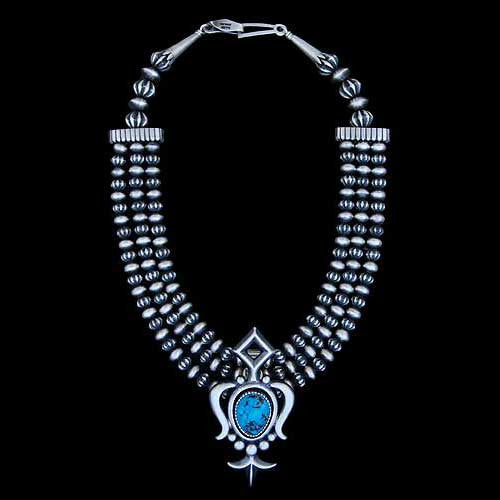
Navajo Kingman Turquoise and Sterling Silver Triple Bead Strand Necklace - Allison Lee (#124)
$3,000.00
Artist: Allison Lee
Navajo Jewelry
Necklace: 18" long
Pendant: 3" tall x 1 1/2" wide
Stone: 7/8" tall x 5/8" wide
We offer a 100% satisfaction guarantee on every purchase.
Kingman Turquoise
Kingman Turquoise comes from a large open-pit copper mine in the Mineral Park Mining District, northwest of Kingman, Arizona and was one of the largest turquoise mines in this country. The area lies in high desert country at an elevation of 3,345 feet and is surrounded by three mountain ranges. The mining district around Kingman, Arizona has always been a large producer of turquoise, at one time the world's largest. First mined by Indians, this area was home to the most extensive prehistoric workings found in Arizona.
The modern production of turquoise dates back to the early 1880’s when James Haas rediscovered these ancient Kingman area mines. Much of the turquoise occurred as seams, masses and veins. The color of natural Kingman turquoise can range from light blue to very dark blue and sometimes tints of green. The matrix is from white, light brown to black and frequently flecked with pyrite and times quartz. The mine became famous for its rounded, bright blue nuggets with black matrix. Few turquoise mines produced nuggets, especially of this quality. In its high-grade form it has always been considered among the top quality American turquoise. With so many thousands of pounds of good quality turquoise produced in the Kingman area over the last one hundred years it is hard to believe that today very little high-grade Kingman turquoise is available.
Other names for Kingman turquoise: Ithaca Peak, The Wall, Tiffany, Courtland, Az., Gleeson
Most desirable: Deep Blue with molybdenum pyrite; Real blue with pyrite; Bird's eye; Water Web; Nuggets
About the artist:

Allison Lee - Navajo Silversmith:
Speaking of the silver and gold jewelry he hand crafts, Allison Lee's captivating voice is sincere when he says, "One time my uncle told me that everything we build comes from the earth, like the silver that comes from the earth, or the turquoise that comes from the earth. That is a lot of energy. You put it together and you put your heart and mind into a piece. Then sometimes a certain piece of jewelry- I believe- it is made for a certain person. I usually have a ring, or something, that stays with me for about two or three years, until the right person comes along. And then that person buys that piece. I believe that every piece of jewelry that I make is made for somebody out there- it's made for somebody special. Whoever might be having problems, or something like that. In essence, that energy helps that person get help, by wearing pieces that we make. That is the way I look at it.
Related legends:
Silversmith Work
When and how the Navajo acquired the art of working metals is unknown but there are reasons for supposing that it was introduced among them, or at least more developed and improved upon by them, since the time they have occupied their present country?
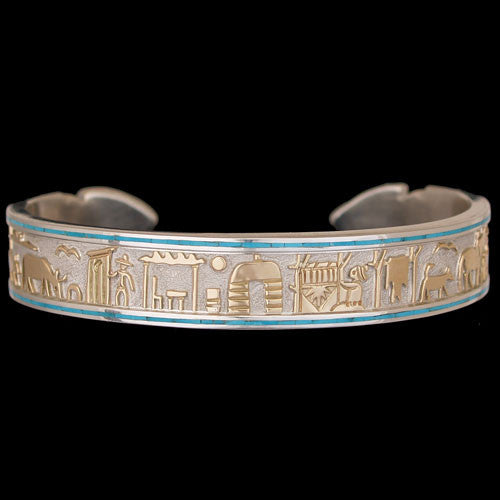
Navajo Sterling Silver and 14k Gold with Sleeping Beauty Turquoise Lifestyle Bracelet - Robert Taylor (#44)
$2,975.00
Artist: Robert Taylor
Navajo Jewelry
Inner Circumference: 6 1/4"
Opening: 1 1/8"
Total: 7 3/8"
When it comes to Robert Taylor’s work, gold and silver go together like Navajo and sheep. So, as you can see, this Navajo lifestyle bracelet is the perfect combination, symbolically and culturally, artistically and aesthetically, naturally and truthfully. Robert is a great guy and a great artist. Oh yea, did we say we love this bracelet.
We offer a 100% satisfaction guarantee on every purchase.
Sleeping Beauty Turquoise
The Sleeping Beauty turquoise mine is located seven miles from Globe, Arizona. The mine is one of the largest producers of turquoise in North America. The mine, and the turquoise extracted from it, derives its name from Sleeping Beauty Mountain, which at one time was part of the Copper Cities operation. The center of the copper mine is located at approximately 33o24"13.23"N. 110o53'34. 60"W, at an elevation of 1224 feet. Sleeping Beauty Turquoise Mining is presently owned and operated by Monty Nichols.
For many centuries before the first Europeans made their way into Arizona, turquoise was being mined on the slopes of Sleeping Beauty Mountain. The Salado and other ancient peoples mined the beautiful sky stone from several surface outcroppings located in the vicinity, including Pinto Valley. It is believed that Spanish explorers were the first Europeans to locate the source of Sleeping Beauty sometime around the 1860s. By the 1870s, small underground mines pockmarked the hills surrounding present day Globe.
Cities Service Company started the Copper Cities Mine (commonly called the Sleeping Beauty Mine) in 1952 and operated it until the Pinto Valley mine opened in 1972. During the 1960s, L.W. Hardy had the contract to mine turquoise, both at Sleeping Beauty and at Castle Dome, later called the Pinto Valley Mine. Formerly a meat cutter at a market in Miami, Hardy recognized early on that turquoise was more valuable as a gemstone than the associated copper.
By the time the turquoise boom began, Hardy had contracts with mining companies in Miami, Kingman and elsewhere. He also developed a method for stabilizing low-grade, porous turquoise with pressure-impregnated hot acrylic resin, which hardened the stone and improved the color.
Hardy's mining methods were primitive when compared with current operations. Hardy's workers sat in a ditch ripped by a bulldozer and hand picked the stone from waste-rock. Hardy mined turquoise at Sleeping Beauty for 22 years, getting about 45 percent recovery, and leaving the rest in waste dumps.
Monty Nichols received the contract to mine Sleeping Beauty turquoise in 1988, and began using modern mining methods to develop the property. Nichols drills and blasts the overburden, hauling it to the abandoned Copper Cities pit, which now contains the recycled tailings from Miami Copper Company's No. 5 tailing dam. The old dam dominated the eastern skyline of downtown Miami until recently. The year Nichols acquired the contract; he began a two-year project to remove 5,000.000 tons of overburden. Located half way up the side of an open pit mine, the narrow turquoise-bearing zone has about 400 feet of hard waste rock on top of it. In order to move sideways into the ore-body, a whole slice of the mountain had to be removed.
To avoid fracturing the turquoise, Nichols was careful not to blast too near the turquoise-bearing strata. That layer is more crumbly, so the miners can rip it and dump it over screens, separating the material by size. No crushers are used, again to avoid fracturing the gemstone, and the different sized rock is hauled up to a wide mine bench where conveyor belts move the material through three buildings. There, workers handpick turquoise from the broken rock. The buildings are vented with filtered air to eliminate workers' exposure to dust, and well insulated to keep them comfortable in any weather. It is a far cry from the old methods of mining. Anywhere from 30 to 40 people work at the mine at any one time, depending on how much mining there is to do.
Fifty years ago, mine workers filled lunch buckets with the colorful rock, even though it was reason for immediate termination. Old habits die hard, and some people still think it is okay to sneak in and try to pick turquoise. As a result, security is tight in and around the mine. Motion detectors, night vision cameras and 24/7 roving patrols are used, so the only turquoise leaving the property now is being shipped to markets around the world.
Italy is the largest volume buyer of Sleeping Beauty turquoise, with Germany and Hong Kong following closely behind. These customers buy the best grade for their exclusive jewelry. Jewelry makers in India and Spain also receive Sleeping Beauty turquoise, while in the U.S., Gallup and Albuquerque are the largest consumers.
The Sleeping Beauty turquoise mine produces a uniform light to medium blue turquoise with rare finds of deep, dark blue. Because of its uniformity, it has been a favorite of the Zuni Pueblo. Zuni silversmiths often use it in channel inlay and various types of cluster work that require large numbers of small, perfectly matched stones. The Sleeping Beauty mine has been one of the larger producers of rough turquoise in the United States, although today much less good turquoise is being produced than in the past.
Sleeping Beauty turquoise is noted for its solid, light blue color with no matrix; the host rock is usually granite. Nichols says the mine is producing about 1,600 pounds a month. Of that, only four percent is natural; most of the turquoise from the mine is altered in some way. Most is enhanced, which is more expensive than stabilization, and sold to large distributors in this country and Europe. Currently most of the turquoise that comes from the mine is from the tons of tailings piles that have been accumulating for decades.
The best of the Sleeping Beauty turquoise is comparable to that found in the Middle East. It is thought that large quantities of Sleeping Beauty turquoise is taken overseas and smuggled into, then out of, Iran to be sold as “Persian” turquoise.
About the artist:

Robert Taylor - Silver & Goldsmith:
"Cluster, channel, leaf, inlay, casting... I've done about everything," Robert Taylor talks about his silver and goldsmithing, "There's a lot of artists that do it." And then he confides the reason he has set himself apart from other craftsmen. "I didn't really get anywhere until I decided to design my own style."
Related legends:
Silversmith Work
When and how the Navajo acquired the art of working metals is unknown but there are reasons for supposing that it was introduced among them, or at least more developed and improved upon by them, since the time they have occupied their present country?
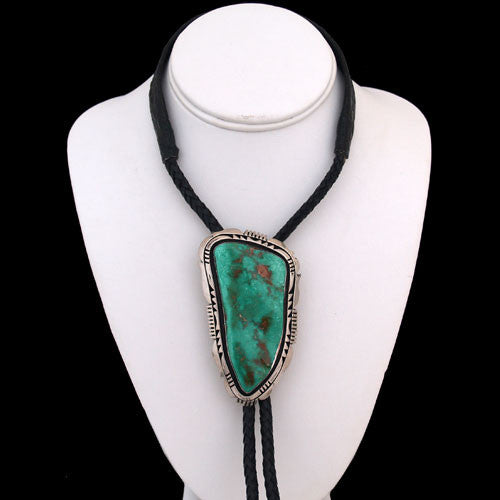
Navajo Natural Gem Grade Royston Turquoise Bolo Tie - Will Denetdale (#262)
$2,800.00
Artist: Will Denetdale
Bolo: 2" x 3 1/2"
Will Denetdale has fashioned this striking bolo tie in his classic double stack design. The fabulous cabochon of high-grade, natural Royston turquoise is cut in an appealing baroque shape that lends itself perfectly to Will's free-form style. We have had this stone many years, patiently waiting to have it set in a mounting worthy of its quality rating. When it comes to handing over prized possessions, Will is one of the few artists we give free rein. We have never been disappointed with the results of his creative process. He hand fashions jewelry for several clients, but seems happiest when precious products come across his workbench. He takes much more time and puts in a lot more effort to assure a dramatic finished product. The end result is always fabulous.
Royston Turquoise
The Royston Mining District lies on the Nye-Esmerelda County line, about 24 miles northwest of Tonopah, Nevada. In this area, turquoise mines are scattered for nearly a mile along a shallow canyon. Because it involves many small producers, the Royston district is one of the better-known turquoise mining areas in Nevada. Three of the district's more important turquoise mines are the Royal Blue, Bunker Hill and the Oscar Wehrend.
The Royal Blue mine constitutes the main turquoise workings in the district. This turquoise shows as fine-grained, altered porphyry, which is soft in places, although much of it has been hardened by silification. The turquoise is found principally in veinlets and seams, with minor lenses and nodules. The veinlets and lenses range from a fraction of an inch to more than an inch in thickness. Masses of turquoise, filling brecciated matrix, have, however, been found more than five inches thick. Lens shaped pieces of turquoise weighing an ounce or two are not uncommon, and one piece weighing nearly a pound and a half were found.
Royston turquoise ranges in color from dark and pale blue to various shades of green. Some of the dark blue turquoise has a slightly greenish cast, and some is nearly pure blue in color. The dark blue turquoise and that with a greenish cast are very fine grained and hard; the lighter colored ore is generally softer. The best turquoise is often found in limonite stained rock, and the pale blue, softer turquoise is found in light colored, softer porphyry. The quality of the best pure blue stones from the Royal Blue is equal to that found in any American mine and the matrix is especially fine.
The hard turquoise veins and nuggets are coated with a crust or stain of dark to light shading, and at times include a yellow limonite. This stain penetrates the turquoise along seams and branching cracks, producing attractive patterns and contrasts of color. Some large specimens have consisted of a patchwork of dark blue with a slightly greenish tint, marked in places with a very dark red-brown matrix. These cut gems can exhibit exceedingly wide variations of shading, and the matrix contrasts are often striking. Great spider webbing in green or blue nuggets and unusual scenic turquoise pieces are a hallmark of Royston
Two prospectors named Workman and Davis, who later sold the mine to William Petry for $3,000.00, discovered the mine in 1902. Petry improved the mine to the point of assuring its production, and, in 1907, sold it to The Himalaya Mining Co., which was owned by Julius Tannenbaum of Los Angeles and New York. Tannenbaum owned a number of mines in Nevada and California. During 1908 and 1909, the property was systematically and actively worked under the directions of Julius Goldsmith, Tanenbaum's son-in-law. Tannenbaum died suddenly about 1910, and Goldsmith hurried east to settle the estate. Shortly afterwards, he ordered operations abandoned and about 1911 sold the mine back to Petry. Petry and W. I. Miller, who had been Petry's mine boss, operated the mine for a time, and then leased it to Lee Hand and Bert Kopenhaver. Hand and Kopenhaver worked the mine dumps for a time, and then bought the mine outright from Petry. Kopenhaver later sold his share to Charley Bona. Hand and Bona worked the mine periodically, and in 1936 Bona sold his interest to Ted Johnson. In 1940 Johnson sold his share to Lee Hand.
The Otteson family now works the mine. The Otteson story began in 1944 with Lynn Otteson. Lynn brought his family to Nevada to mine turquoise and leased his first Royston claim from Lee Hand. At that time, Hand owned approximately 30 claims in the Royston district. The Otteson family has owned or leased turquoise claims in this district for the past 60 years. The Royal Blue mine has been one of the major turquoise producers in the state of Nevada. For some time, the mine produced as much as 1,250 pounds of turquoise a month, and several times has exceeded that amount.
Petry, at the time he sold the mine to Hand and Kopenhaver, declared that the Royal Blue had produced more gem quality turquoise than any mine in the United States. He placed the value of cut stones taken from the mine at more than $5 million. There is no adequate estimate of the value of gems produced from the mine in the years since that time.
The Bunker Hill is about half a mile north of The Royal Blue. In this mine, turquoise occurs in altered quartzite and ranges from royal blue to greenish blue with brown with white matrix. Turquoise is mainly in the form of slabs from 1/16 of an inch to a full inch thick. The mine was discovered in 1927 by Roy Palfreyman and Bert Kopenhaver, and was originally opened as a small shaft about 20 feet deep. As the turquoise was unearthed, the shaft was widened along the seam into a long stope, which was eventually opened into a glory hole. Polfreyman and Kopenhaver took out about $30,000 worth of turquoise, then sold to the owners of the Royal Blue mine, who produced about $75,000 worth of material. The mine eventually was incorporated into the Royal Blue group of claims.
The Oscar Wehrend mine, in the Royston district, is about 1/3 of a mile from the main workings of the Royal Blue. The turquoise is in highly altered rocks, where it forms seams, coatings and nodules as large as 2 inches thick. It is mostly soft, pale, and not of very good quality. Its color and hardness can, however, be improved by artificial means. Oscar Wehrend discovered the deposit in 1909, but Lee Hand conducted much of the work. Production from the property has been small.
The Royston Mine was originally worked as a silver mine in the late 1800s, Large deposits of high quality turquoise led Tiffany's of New York to incorporate quality green and blue turquoise stones from the Royston Hills into their jewelry lines prior to WWII. There was a brief surge of Royston turquoise production in the 1970s, and the Royston district is still producing limited amounts of high quality turquoise. The turquoise currently being produced from the Royston district is mined by Dean and Danny Otteson, and is coming from the Royal Royston claim.
About the artist:

Will Denetdale - Navajo Jewelry:
One of the most talented Navajo gold and silversmiths currently producing jewelry, Will Denetdale is making an indelible mark in the world of Native American art. His name is becoming famous in his trade; his art a standard by which other pieces may be judged. Will's success as an artist is proportionate to his devotion, and Will Denetdale lives to make jewelry.
Related legends:
Precious Stones
Turquoise; Precious stones have symbolic implications. For example, turquoise if a "collective term for all the precious stones, wealth, or mixed offerings. Good fortune is attributed to this stone." Both white shell and turquoise are emphasized in Kinaalda? More about this legend
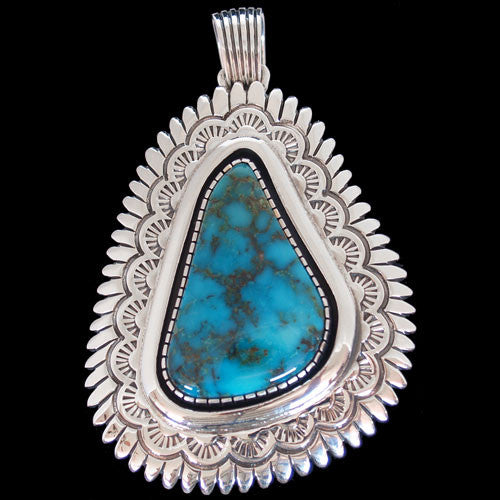
Navajo Natural Blue Gem 38cts Turquoise Pendant - Allison Lee (#194)
$2,775.00
Artist: Allison Lee
2" x 3 1/8"
Stone: 7/8" x 1 1/2"
It has taken Allison Snowhawk Lee over 40 years to achieve the level of sophistication he now has in his art. His attention to detail is, in a word, amazing, and his finish work is so crisp and squeaky clean it is hard to believe. The stamp and file work on this pendent must be examined under magnification to really appreciate it. The turquoise is super high-grade natural from the Blue Gem mine in Nevada. It is incredible. This pendent is "over the top."
Blue Gem Turquoise
Blue Gem turquoise occurs in argillized quartz monzonite cut by two limonite-stained sheer zones, one trending N 35 o W and dipping 75 o NE, the other trending N, 25 o E and dipping 55 o NW. An extensive breccia zone about 10 feet wide is developed between the two bounding sheers. Exceptionally good quality turquoise forms veins up to three-quarters of an inch thick along the shears. Pyrite-bearing quartz veins are closely associated with the turquoise.
The Blue Gem mine was at one time located deep underground, accessed by tunnels as deep as 800 feet. This is of interest because the Blue Gem Mine and the Bisbee Mine in Arizona are the only two mines (of which we are aware) that turquoise was found that deep in the earth. The Blue Gem mine was once developed in extensive underground workings and open stoops. An audit several hundred feet long on the main structure connected to numerous shorter tunnels and several open stoops. Directly above the main audit was a glory hole some 100 feet long.
Duke Goff first noted the Blue Gem deposit in 1934. It was subsequently leased from the Copper Canyon Mining Co. by the American Gem Co. of San Gabriel, CA., owned by Doc Wilson and his sons, Del and William. The company operated the property until 1941 when the outbreak of the war caused a shortage of experienced miners. Both Del and William Wilson were called into the Army for the duration of the war, and this compelled the closing of the mine. Consequently, the lease was allowed to lapse and work was abandoned. In 1950 Lee Hand and Alvin Layton of Battle Mountain leased the mine.
Production of turquoise at the Blue Gem lease in the early days of the operation was enormous. Although there is no exact information, it is reported that the output amounted to nearly
$1 million in rough turquoise. The mine is still active, although Duval Corp is currently in the center of a major copper deposit developing it.
Pyrite in Blue Gem is unusual to see but not unheard of. Very little large material ever came out of Blue Gem, the majority found was small 1-mm "bleeder" veins and tiny nuggets which was perfect for Zuni inlay and fine needlepoint, petit-point and snake-eyes jewelry. Blue Gem turquoise was very popular in the late 1930's and 40's and was commonly used in the Fred Harvey "tourist jewelry" that is so collectable today. Blue Gem turquoise is extremely hard and stands up well to the test of time.
Blue Gem turquoise is a rare, valuable and historic American treasure. Quality Blue Gem Turquoise has been gifted with a wide range and variety of color. Because Blue Gem turquoise is very hard, a high polish is associated with this stone, and unlike most turquoise, won't easily change color. This turquoise has a unique character and many different looks all of which are striking, full of wonder and pleasing to the eye.
Production of the mine started about 1934 and continued into the 1970's. Blue Gem Turquoise is still some of the finest turquoise ever found, and unlike most turquoise mines, (in which the majority mined is chalky and only usable if stabilized) most of the turquoise found there was of gem-quality. Today the Blue Gem mine is not viable; it sits in the middle of a huge mining operation. The emphasis is on precious metals and the extraction of turquoise is considered more of a hindrance in the mining process rather than an asset. Even the ever-popular "Dump Diving" for turquoise through the overburden is not tolerated due to the very real danger of becoming buried in a slide. Insurance factors, equipment hazards, high explosives and safety issues along with a lack of interest from the mining company keep Blue Gem turquoise unavailable to the world, at least for now.
About the artist:

Allison Lee - Navajo Silversmith:
Speaking of the silver and gold jewelry he hand crafts, Allison Lee's captivating voice is sincere when he says, "One time my uncle told me that everything we build comes from the earth, like the silver that comes from the earth, or the turquoise that comes from the earth. That is a lot of energy. You put it together and you put your heart and mind into a piece. Then sometimes a certain piece of jewelry- I believe- it is made for a certain person. I usually have a ring, or something, that stays with me for about two or three years, until the right person comes along. And then that person buys that piece. I believe that every piece of jewelry that I make is made for somebody out there- it's made for somebody special. Whoever might be having problems, or something like that. In essence, that energy helps that person get help, by wearing pieces that we make. That is the way I look at it.
Related legends:
Silversmith Work
When and how the Navajo acquired the art of working metals is unknown but there are reasons for supposing that it was introduced among them, or at least more developed and improved upon by them, since the time they have occupied their present country?
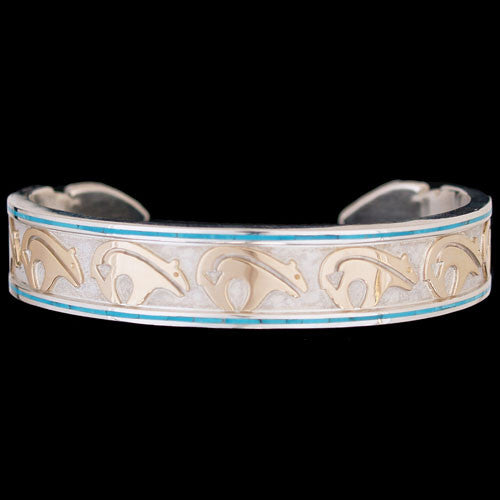
Navajo 14k Gold and Turquoise Bear Fetish Bracelet - Robert Taylor (#43)
$2,750.00
Artist: Robert Taylor
Navajo Jewelry
Inner Circumference: 5 3/4"
Opening: 1"
Total: 6 3/4"
Navajo silversmith Robert Taylor wanted to share a bit of safety and stability with this wrist cuff. Bears are a gift of Changing Woman to guard the people, and arrowheads are a gift of Grandfather Horned Toad to protect against great danger. Robert wrapped his golden bear in shrouds of blue sky, to show that higher powers are involved. Robert Taylor is a master silversmith; his designs are graceful and dramatic at the same time and his finish detail is amazing.
We offer a 100% satisfaction guarantee on every purchase.
About the artist:

Robert Taylor - Silver & Goldsmith:
"Cluster, channel, leaf, inlay, casting... I've done about everything," Robert Taylor talks about his silver and goldsmithing, "There's a lot of artists that do it." And then he confides the reason he has set himself apart from other craftsmen. "I didn't really get anywhere until I decided to design my own style."
Related legends:
Protection/Practice
Ambush, a shelter formed by two trees or shrubs whose branches intermingle, is a setting repeatedly occurring in myth, giving the explanation for various ritualistic properties-emetic frames, hoops, pokers, prayersticks, wood samples. A hero, hoping to shoot a mountain sheep or other animal he did not recognize as a god, lay behind the 'ambush trees,' but when the animal appeared, was numb until it had passed. The animal deity, revealing himself, taught the hero ceremonial lore? More about this legend
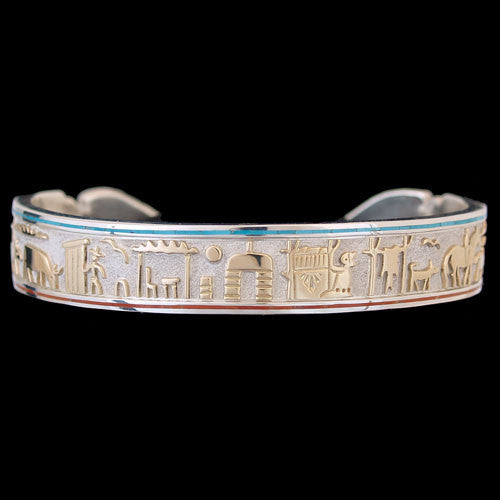
Navajo 14k Gold, Turquoise, and Coral Protection Brecelet - Robert Taylor (#42)
$2,750.00
Artist: Robert Taylor
Navajo Jewelry
Inner Circumference: 6 1/4"
Opening: 1 1/8"
Total: 7 3/8"
Turquoise and coral, silver and gold, land and sky, shepherd and livestock; these are combinations as old as Navajo culture itself. Robert Taylor combines all these elements to make one extraordinary man’s bracelet. Robert’s sense of humor is as well developed as his silversmithing skills, so you get a humorous commentary on Navajo lifestyle in a cuff you will treasure the rest of your life, and maybe into the afterlife.
We offer a 100% satisfaction guarantee on every purchase.
About the artist:

Robert Taylor - Silver & Goldsmith:
"Cluster, channel, leaf, inlay, casting... I've done about everything," Robert Taylor talks about his silver and goldsmithing, "There's a lot of artists that do it." And then he confides the reason he has set himself apart from other craftsmen. "I didn't really get anywhere until I decided to design my own style."
Related legends:
Protection/Practice
Ambush, a shelter formed by two trees or shrubs whose branches intermingle, is a setting repeatedly occurring in myth, giving the explanation for various ritualistic properties-emetic frames, hoops, pokers, prayersticks, wood samples. A hero, hoping to shoot a mountain sheep or other animal he did not recognize as a god, lay behind the 'ambush trees,' but when the animal appeared, was numb until it had passed. The animal deity, revealing himself, taught the hero ceremonial lore? More about this legend
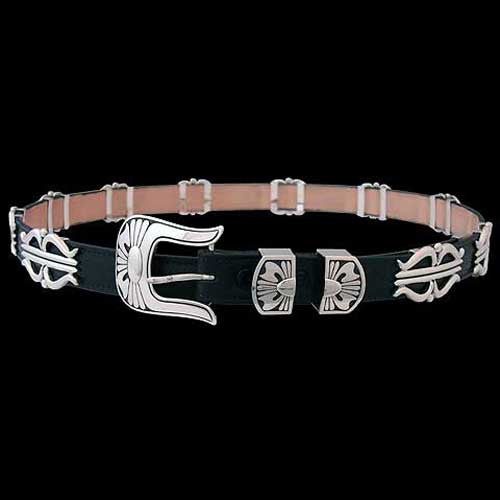
Navajo Overlay Belt & Sand Cast Conchos - Allison Snowhawk Lee #054
$2,750.00
Artist: Allison Snowhawk Lee
About the artist:

Allison Lee - Navajo Silversmith:
Speaking of the silver and gold jewelry he hand crafts, Allison Lee's captivating voice is sincere when he says, "One time my uncle told me that everything we build comes from the earth, like the silver that comes from the earth, or the turquoise that comes from the earth. That is a lot of energy. You put it together and you put your heart and mind into a piece. Then sometimes a certain piece of jewelry- I believe- it is made for a certain person. I usually have a ring, or something, that stays with me for about two or three years, until the right person comes along. And then that person buys that piece. I believe that every piece of jewelry that I make is made for somebody out there- it's made for somebody special. Whoever might be having problems, or something like that. In essence, that energy helps that person get help, by wearing pieces that we make. That is the way I look at it.
Related legends:
Silversmith Work
When and how the Navajo acquired the art of working metals is unknown but there are reasons for supposing that it was introduced among them, or at least more developed and improved upon by them, since the time they have occupied their present country?
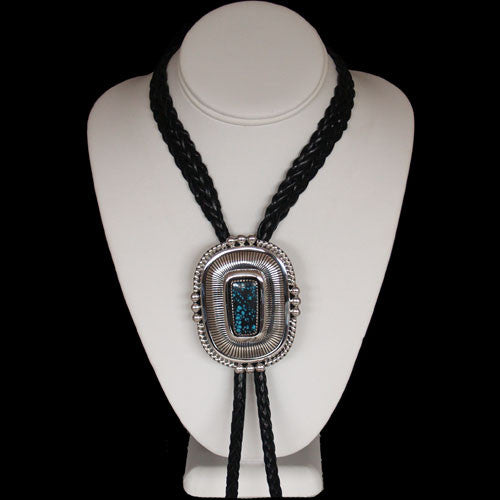
Navajo Lone Mountain Turquoise Sterling Silver Bolo Tie - Allison Lee (#175)
$2,500.00
Artist: Allison Lee
Navajo Jewelry
Bolo: 2 1/2" x 3"
Strap: 43"
Man, if you want a bolo tie to replace your current silk ones, this is it! With a spectacular, and I mean spectacular, piece of Lone Mountain turquoise set in an Allison Lee mounting, you will receive raves when you wear it.
We offer a 100% satisfaction guarantee on every purchase.
Lone Mountain Turquoise
The Lone Mountain turquoise mine is located near Tonapah, in Esmeralda County, Nevada. Since it is known for producing a high percentage of gem-grade turquoise, it is often referred to as a "sweet heart" mine. Originally established in 1920 by Lee Hand, the claim was initially called the Blue Jay Mining Lode. Later, after noting that so many other mines had been named Blue Jay, Hand changed its name to Lone Mountain.
In 1927, at a depth of about 40 feet, Bert Kopenhaver, who had leased the mine from Hand, found the beautiful spider web turquoise that made Lone Mountain one of the top mines in the Southwest. Although it has change hands several times over the years, the mine still produces a small amount of quality material. The Lone Mountain claim is currently owned by Gene Wadell and operated by Chris Lott.
Also known for exquisite, deep blue stones, the mine has historically produced some of the highest quality spider web turquoise in the world. "Fossil turquoise" has also been found in the mine. This was formed when ancient plants and seashells dissolved, leaving only cavities that were later filled with turquoise deposits. Additionally, turquoise nuggets in moss agate have been found. Because of its extraordinary hard nature, Lone Mountain turquoise has the ability to retain its rich color and is therefore a valuable addition to any jewelry collection.
About the artist:

Allison Lee - Navajo Silversmith:
Speaking of the silver and gold jewelry he hand crafts, Allison Lee's captivating voice is sincere when he says, "One time my uncle told me that everything we build comes from the earth, like the silver that comes from the earth, or the turquoise that comes from the earth. That is a lot of energy. You put it together and you put your heart and mind into a piece. Then sometimes a certain piece of jewelry- I believe- it is made for a certain person. I usually have a ring, or something, that stays with me for about two or three years, until the right person comes along. And then that person buys that piece. I believe that every piece of jewelry that I make is made for somebody out there- it's made for somebody special. Whoever might be having problems, or something like that. In essence, that energy helps that person get help, by wearing pieces that we make. That is the way I look at it.
Related legends:
Silversmith Work
When and how the Navajo acquired the art of working metals is unknown but there are reasons for supposing that it was introduced among them, or at least more developed and improved upon by them, since the time they have occupied their present country?
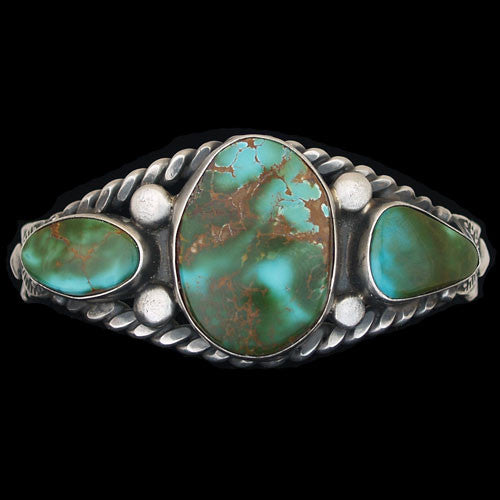
Navajo Royston Turquoise Sterling Silver Bracelet - Victor Begay (#33)
$2,495.00
Artist: Victor Begay
Navajo Jewelry
Inner Circumference: 5"
Opening: 1"
Total: 6"
Width: 1 1/4"
When it comes to Royston turquoise character is the name of the game, and this cuff, featuring a suite of three smashing character stones, shines like a beacon. Navajo silversmith Victor Begay knew not to get too complex with the metalwork and left the stones to stand on their own. Surely the crowds will hover when they see you wearing this.
We offer a 100% satisfaction guarantee on every purchase.
Royston Turquoise
The Royston Mining District lies on the Nye-Esmerelda County line, about 24 miles northwest of Tonopah, Nevada. In this area, turquoise mines are scattered for nearly a mile along a shallow canyon. Because it involves many small producers, the Royston district is one of the better-known turquoise mining areas in Nevada. Three of the district's more important turquoise mines are the Royal Blue, Bunker Hill and the Oscar Wehrend.
The Royal Blue mine constitutes the main turquoise workings in the district. This turquoise shows as fine-grained, altered porphyry, which is soft in places, although much of it has been hardened by silification. The turquoise is found principally in veinlets and seams, with minor lenses and nodules. The veinlets and lenses range from a fraction of an inch to more than an inch in thickness. Masses of turquoise, filling brecciated matrix, have, however, been found more than five inches thick. Lens shaped pieces of turquoise weighing an ounce or two are not uncommon, and one piece weighing nearly a pound and a half were found.
Royston turquoise ranges in color from dark and pale blue to various shades of green. Some of the dark blue turquoise has a slightly greenish cast, and some is nearly pure blue in color. The dark blue turquoise and that with a greenish cast are very fine grained and hard; the lighter colored ore is generally softer. The best turquoise is often found in limonite stained rock, and the pale blue, softer turquoise is found in light colored, softer porphyry. The quality of the best pure blue stones from the Royal Blue is equal to that found in any American mine and the matrix is especially fine.
The hard turquoise veins and nuggets are coated with a crust or stain of dark to light shading, and at times include a yellow limonite. This stain penetrates the turquoise along seams and branching cracks, producing attractive patterns and contrasts of color. Some large specimens have consisted of a patchwork of dark blue with a slightly greenish tint, marked in places with a very dark red-brown matrix. These cut gems can exhibit exceedingly wide variations of shading, and the matrix contrasts are often striking. Great spider webbing in green or blue nuggets and unusual scenic turquoise pieces are a hallmark of Royston
Two prospectors named Workman and Davis, who later sold the mine to William Petry for $3,000.00, discovered the mine in 1902. Petry improved the mine to the point of assuring its production, and, in 1907, sold it to The Himalaya Mining Co., which was owned by Julius Tannenbaum of Los Angeles and New York. Tannenbaum owned a number of mines in Nevada and California. During 1908 and 1909, the property was systematically and actively worked under the directions of Julius Goldsmith, Tanenbaum's son-in-law. Tannenbaum died suddenly about 1910, and Goldsmith hurried east to settle the estate. Shortly afterwards, he ordered operations abandoned and about 1911 sold the mine back to Petry. Petry and W. I. Miller, who had been Petry's mine boss, operated the mine for a time, and then leased it to Lee Hand and Bert Kopenhaver. Hand and Kopenhaver worked the mine dumps for a time, and then bought the mine outright from Petry. Kopenhaver later sold his share to Charley Bona. Hand and Bona worked the mine periodically, and in 1936 Bona sold his interest to Ted Johnson. In 1940 Johnson sold his share to Lee Hand.
The Otteson family now works the mine. The Otteson story began in 1944 with Lynn Otteson. Lynn brought his family to Nevada to mine turquoise and leased his first Royston claim from Lee Hand. At that time, Hand owned approximately 30 claims in the Royston district. The Otteson family has owned or leased turquoise claims in this district for the past 60 years. The Royal Blue mine has been one of the major turquoise producers in the state of Nevada. For some time, the mine produced as much as 1,250 pounds of turquoise a month, and several times has exceeded that amount.
Petry, at the time he sold the mine to Hand and Kopenhaver, declared that the Royal Blue had produced more gem quality turquoise than any mine in the United States. He placed the value of cut stones taken from the mine at more than $5 million. There is no adequate estimate of the value of gems produced from the mine in the years since that time.
The Bunker Hill is about half a mile north of The Royal Blue. In this mine, turquoise occurs in altered quartzite and ranges from royal blue to greenish blue with brown with white matrix. Turquoise is mainly in the form of slabs from 1/16 of an inch to a full inch thick. The mine was discovered in 1927 by Roy Palfreyman and Bert Kopenhaver, and was originally opened as a small shaft about 20 feet deep. As the turquoise was unearthed, the shaft was widened along the seam into a long stope, which was eventually opened into a glory hole. Polfreyman and Kopenhaver took out about $30,000 worth of turquoise, then sold to the owners of the Royal Blue mine, who produced about $75,000 worth of material. The mine eventually was incorporated into the Royal Blue group of claims.
The Oscar Wehrend mine, in the Royston district, is about 1/3 of a mile from the main workings of the Royal Blue. The turquoise is in highly altered rocks, where it forms seams, coatings and nodules as large as 2 inches thick. It is mostly soft, pale, and not of very good quality. Its color and hardness can, however, be improved by artificial means. Oscar Wehrend discovered the deposit in 1909, but Lee Hand conducted much of the work. Production from the property has been small.
The Royston Mine was originally worked as a silver mine in the late 1800s, Large deposits of high quality turquoise led Tiffany's of New York to incorporate quality green and blue turquoise stones from the Royston Hills into their jewelry lines prior to WWII. There was a brief surge of Royston turquoise production in the 1970s, and the Royston district is still producing limited amounts of high quality turquoise. The turquoise currently being produced from the Royston district is mined by Dean and Danny Otteson, and is coming from the Royal Royston claim.
Related legends:
Precious Stones
Turquoise; Precious stones have symbolic implications. For example, turquoise if a "collective term for all the precious stones, wealth, or mixed offerings. Good fortune is attributed to this stone." Both white shell and turquoise are emphasized in Kinaalda? More about this legend
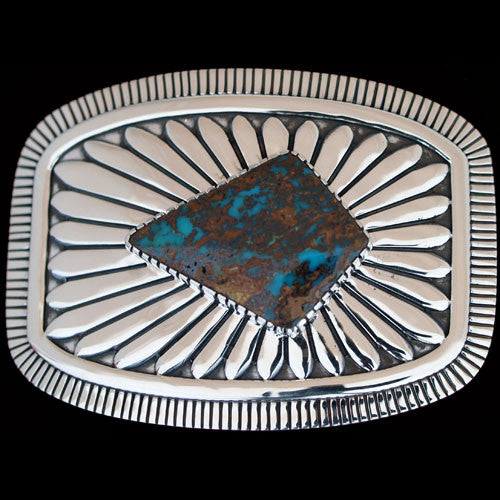
Navajo Tyrone Turquoise Buckle - Allison Lee (#163)
$2,400.00
Artist: Allison Lee
ATC
Navajo Jewelry
3" x 2"
Oh, Allison Lee the silversmith, who never, never, never disappoints. His work is so classically clean it makes you weep. Using a 24.3 carat piece of Tyrone turquoise and his hallmark stamping, Allison has hammered out a buckle that would make anyone shine.
We offer a 100% satisfaction guarantee on every purchase.
Tyrone Turquoise
The Tyrone turquoise mining district is made up of a small cluster of mines in the Burro Mountains near Silver City, New Mexico. This group of mines is associated with the Tyrone Copper mine owned by Phelps-Dodge. Many turquoise historians believe that more high-grade, natural turquoise was produced in this area than any single American turquoise deposit on record. Turquoise mining in the Burro Mountains has been traced back to prehistoric times. Spanish colonists mined the workings in their own time. Mining artifacts such as stone and metal tools along with fragments of turquoise mined in this fashion were common at the sites.
An early mining engineer, named Zalenski, who visiting the mines in 1907, witnessed traces the "fire-fracture" process of extracting turquoise from the host rock. Zalenski also documented one forty-foot shaft though most of the workings. The main mining process was by way of following a vein through open trenching. Early miners and archivists mention ancient and historical Indian burial grounds in the area. The graves, most often, contained offerings of turquoise. These early excavations helped to determine the locations of some of the more modern claims. According to Pogue, John Coleman aka; "Turquois John" is credited with discovering the first modern mine in the area. While on a hunting trip in 1875, John, along with W.J. Foley and Nicholas Ransome of Silver City, are credited with discovering old excavations. The men were following up on a tip from local Indian traders. Turquoise was presumed present near the town and ancient workings were known to exist in the mountains. Their search of the Burro Mountains and surrounding area proved the rumors to be true.
The largest and most recognized mine of the Tyrone workings was the Azure. The Azure mine was initiated in 1891 and was located 10 miles southwest of Silver City. Pogue states in his 1915 classic; Turquoise, Memoirs of the National Academy of Sciences, wrote; "It has been operated in modern times more extensively than any other turquois mine in this country, and its stones are the equal of the Persian gems.” In 1893 the “Elizabeth Pocket” was discovered, which produced more high-grade turquoise than any single deposit on record. The Elizabeth Pocket was 100 feet long, 40 feet wide, and 40 to 50 feet deep. At the time it was believed to be the riches vein of turquoise ever discovered. Cabochons produced from this mine were marketed throughout the country with ads appearing in Harper and McClure’s magazines. Each gem was engraved with a circle on the back with the ad stating, "None genuine without the ring O on the reverse side.” Because of its extremely hard and durable nature Azure turquoise was guaranteed not to change color. Tyrone turquoise available on today's market is mostly from older collections. In its high-grade form Tyrone turquoise is a hard, translucent, brilliant or deep blue and is highly valued by collectors for it beauty and rarity.
About the artist:

Allison Lee - Navajo Silversmith:
Speaking of the silver and gold jewelry he hand crafts, Allison Lee's captivating voice is sincere when he says, "One time my uncle told me that everything we build comes from the earth, like the silver that comes from the earth, or the turquoise that comes from the earth. That is a lot of energy. You put it together and you put your heart and mind into a piece. Then sometimes a certain piece of jewelry- I believe- it is made for a certain person. I usually have a ring, or something, that stays with me for about two or three years, until the right person comes along. And then that person buys that piece. I believe that every piece of jewelry that I make is made for somebody out there- it's made for somebody special. Whoever might be having problems, or something like that. In essence, that energy helps that person get help, by wearing pieces that we make. That is the way I look at it.
Related legends:
Precious Stones
Turquoise; Precious stones have symbolic implications. For example, turquoise if a "collective term for all the precious stones, wealth, or mixed offerings. Good fortune is attributed to this stone." Both white shell and turquoise are emphasized in Kinaalda? More about this legend
Silversmith Work
When and how the Navajo acquired the art of working metals is unknown but there are reasons for supposing that it was introduced among them, or at least more developed and improved upon by them, since the time they have occupied their present country?
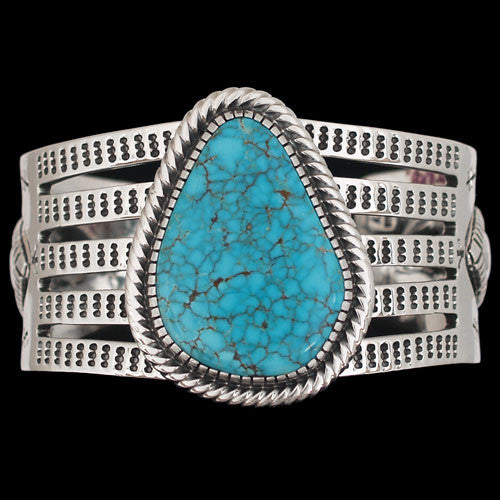
Navajo Natural Gem Grade Morenci Water-web Turquoise Bracelet - Allison Lee (#185)
$2,350.00
Artist: Allison Lee
Total inner circumference including opening: 6 1/2"
Opening: 1 1/4"
Super high-grade, natural, water-web Morenci turquoise is the centerpiece of this remarkable cuff bracelet by Navajo artist Allison Snowhawk Lee. Made in the traditional style, the bracelet is heavy, well made and unusually attractive. Allison is one of the most refined silversmiths of the modern age; his finish detail is enviable and his choice of turquoise top-drawer. When looking for collector-quality jewelry from a Native American artist, look no further than Allison Lee.
Morenci Turquoise
Morenci Turquoise; Arizona Mine, Morenci, Clifton-Morenci District, Shannon Mountains, Greenlee County, Arizona, USA. An open pit copper mine located in the N1⁄2 Section 16, T4S, R29E (Clifton 15 minute topographic map), owned by Phelps Dodge Corp. Map Reference: 33°5'26"N, 109°21'58"W.
Morenci turquoise was mined in southeastern Arizona until approximately 1990. It is located very near the New Mexico border, and ranges in color from classic high electric blue to light azure. Prehistoric Indians who valued the stone for its deep blue color were the first to discover the deposit. These people adorned themselves with rough-hewn beads and carved talisman made from the mineral
Morenci is often associated with an unusual black matrix of irregular iron pyrite, which looks metallic when polished. Although they are rare, stones with unusual birds-eye patterns, red matrix and an occasional layer of silver have also been found. The Morenci name is derived from the large open pit copper mine owned and operated by the Phelps Dodge Corporation. Early examples of this striking turquoise were of the "lunch box" variety, meaning workers and miners carried them out of the mine.
Morenci is well known; it was one of the first types of American turquoise to find its way to the market and is always difficult to obtain because the mine was depleted so long ago. It is believed that the best Morenci ever produced was discovered in the late 1960's to early 70's. During this time period, the mine produced a high, electric blue variety with iron pyrite inclusions. Since Morenci is no longer being mined, and because of its striking color and unusual matrix combinations, high grade natural Morenci is a valuable, highly collectible mineral.
USGS; Arizona.--In Arizona turquoise ranks first in terms of value of production and is also the best known of its gem materials. Nearly all-important deposits of turquoise are located near copper occurrences or in copper deposits in arid desert regions of the world. Thus, the world famous turquoise deposits associated with certain of the large Arizona copper deposits are to be expected.
Turquoise is, or has been, mined from a number of these copper mines as a byproduct, usually by outside contractors. The financial and operating terms of the collecting contracts vary from mine to mine. Some of the operations are little more than the efforts of individual commercial collectors; some are essentially full-scale mining operations that are simultaneous with, but separate from, the regular mining operations; and still others operate on an on-call basis as turquoise is uncovered by the regular copper mining operation. Regardless of the size or sophistication of the initial mining or recovery operation, the actual turquoise is recovered by careful extraction using hand method.
About the artist:

Allison Lee - Navajo Silversmith:
Speaking of the silver and gold jewelry he hand crafts, Allison Lee's captivating voice is sincere when he says, "One time my uncle told me that everything we build comes from the earth, like the silver that comes from the earth, or the turquoise that comes from the earth. That is a lot of energy. You put it together and you put your heart and mind into a piece. Then sometimes a certain piece of jewelry- I believe- it is made for a certain person. I usually have a ring, or something, that stays with me for about two or three years, until the right person comes along. And then that person buys that piece. I believe that every piece of jewelry that I make is made for somebody out there- it's made for somebody special. Whoever might be having problems, or something like that. In essence, that energy helps that person get help, by wearing pieces that we make. That is the way I look at it.
Related legends:
Silversmith Work
When and how the Navajo acquired the art of working metals is unknown but there are reasons for supposing that it was introduced among them, or at least more developed and improved upon by them, since the time they have occupied their present country?
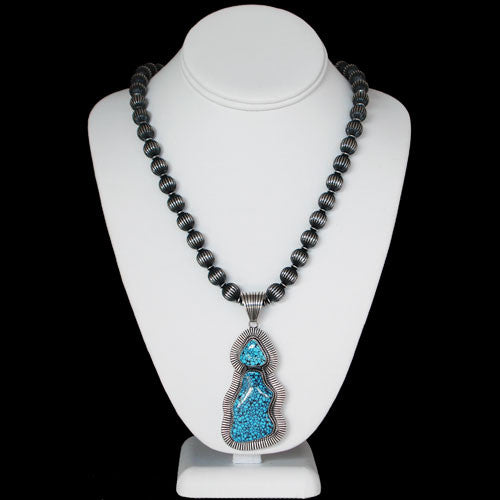
Navajo Natural Gem Grade Kingman Turquoise Necklace - Albert Jake (#59)
$2,250.00
Artist: Albert Jake
Navajo Jewelry
Necklace: 20"
Pendant: 1 1/2" x 3 1/2"
The Navajo believe turquoise was a gift of the gods, pieces of the sky dropped from above by a benevolent hand. Albert Jake discovered two of the more magnificent pieces of skystone and placed them in a setting befitting such treasures. We recognize these fabulous cabochons of high grade, natural turquoise as having come from Kingman, AZ, but who's to say for certain whether they came from heaven or earth. Albert Jake is considered a master silversmith and this pendant, best expresses, just exactly why.
We offer a 100% satisfaction guarantee on every purchase.
Kingman Turquoise
Kingman Turquoise comes from a large open-pit copper mine in the Mineral Park Mining District, northwest of Kingman, Arizona and was one of the largest turquoise mines in this country. The area lies in high desert country at an elevation of 3,345 feet and is surrounded by three mountain ranges. The mining district around Kingman, Arizona has always been a large producer of turquoise, at one time the world's largest. First mined by Indians, this area was home to the most extensive prehistoric workings found in Arizona.
The modern production of turquoise dates back to the early 1880’s when James Haas rediscovered these ancient Kingman area mines. Much of the turquoise occurred as seams, masses and veins. The color of natural Kingman turquoise can range from light blue to very dark blue and sometimes tints of green. The matrix is from white, light brown to black and frequently flecked with pyrite and times quartz. The mine became famous for its rounded, bright blue nuggets with black matrix. Few turquoise mines produced nuggets, especially of this quality. In its high-grade form it has always been considered among the top quality American turquoise. With so many thousands of pounds of good quality turquoise produced in the Kingman area over the last one hundred years it is hard to believe that today very little high-grade Kingman turquoise is available.
Other names for Kingman turquoise: Ithaca Peak, The Wall, Tiffany, Courtland, Az., Gleeson
Most desirable: Deep Blue with molybdenum pyrite; Real blue with pyrite; Bird's eye; Water Web; Nuggets
About the artist:
Since 1959, Albert Jake has made his home in the beautiful country located about forty miles south of Gallup, New Mexico. He was born at Zuni Pueblo and has resided in the village of Ramah for many years. Albert’s parent taught him the many steps to fine Navajo silverwork which includes both cluster jewelry as well as beautiful stones in classic Navajo settings.
Related legends:
Precious Stones
Turquoise; Precious stones have symbolic implications. For example, turquoise if a "collective term for all the precious stones, wealth, or mixed offerings. Good fortune is attributed to this stone." Both white shell and turquoise are emphasized in Kinaalda? More about this legend
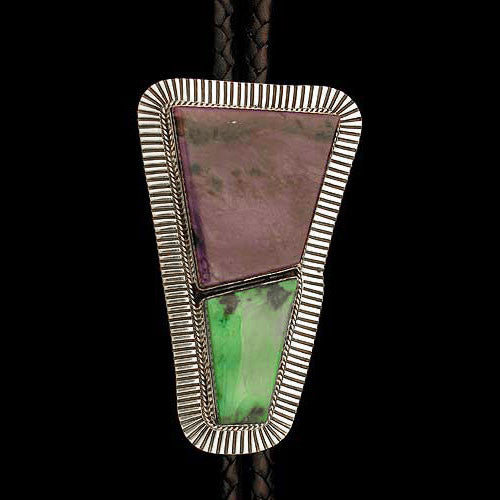
Navajo Persian Turquoise and Sugilite Bolo Tie - Albert Jake (#023)
$2,100.00
Artist: Albert Jake
Navajo Jewelry
Persian Turquoise & Sugilite set in
Sterling Silver Slide on
Purple Leather Bolo Tie
Slide: 1 7/8" x 3"
Bolo: 48" long
Albert Jake decided to take a hunk of sugilite and a hunk of Persian turquoise and make a contemporary bolo tie that is timeless in its design. Albert knows you don’t want to complicate the silver work when you have stones like this. He has therefore used clean, simple stamping and a foundational shape to show off his skills. Very nice indeed.
We offer a 100% satisfaction guarantee on every purchase.
Persian Turquoise
In the Southwest, we tend to take turquoise for granted; yet it has been labeled the “Gemstone of the Centuries”. Over 7,500 years ago, slave convoys were sent into the Sinai Peninsula to pluck pieces of the blue gem from the rocks where it had formed. In ancient Egypt, turquoise was believed to have mystical powers and appeared in amulets and talisman representing their gods Amum and Isis. A gold and carved turquoise bracelet was found on the mummified arm of Queen Zer, a ruler during the first dynasty of Egyptian pharaohs. The four bracelets found in her burial are the earliest known examples of precious metal jewelry.
The Middle East emerged as the great purveyor of turquoise, supplying the ancient Egyptians, Nubians, Greeks and Romans. It is believed the name was derived from the French word, Turquie, a reference to the Turkish traders first bringing the rich blue stones to the European continent. It was assumed that the brilliant blue and green stones originated in Turkey when, in fact, they were most likely extracted from mines in the Sinai Peninsula and the Alimersai Mountain in Persia (Iran).
About the artist:
Since 1959, Albert Jake has made his home in the beautiful country located about forty miles south of Gallup, New Mexico. He was born at Zuni Pueblo and has resided in the village of Ramah for many years. Albert’s parent taught him the many steps to fine Navajo silverwork which includes both cluster jewelry as well as beautiful stones in classic Navajo settings.
Related legends:
Silversmith Work
When and how the Navajo acquired the art of working metals is unknown but there are reasons for supposing that it was introduced among them, or at least more developed and improved upon by them, since the time they have occupied their present country?
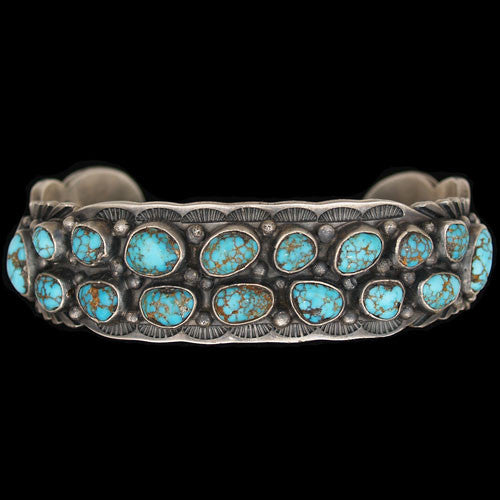
Navajo 1970's Burnham Turquoise 17 Stone Bracelet - Victor Begay (#32)
$1,875.00
Artist: Victor Begay
Navajo Jewelry
Inner Circumference: 5 3/4"
Opening: 1 1/2"
Total: 7 1/4"
Width: 7/8"
Victor Begay of Lukachukai, Arizona sometime in the 1970s, made this bracelet. It was bought by a collector from New York City as a gift for her husband. The bracelet sat in a drawer for nearly 40 years before it was returned to its homeland. We were more than happy to see it. Victor was a prolific artist in that period and produced jewelry of high quality set with top grade turquoise. The stones in this bracelet are from the Burnham mine near Austin, Nevada.
We offer a 100% satisfaction guarantee on every purchase.
Related legends:
Silversmith Work
When and how the Navajo acquired the art of working metals is unknown but there are reasons for supposing that it was introduced among them, or at least more developed and improved upon by them, since the time they have occupied their present country?
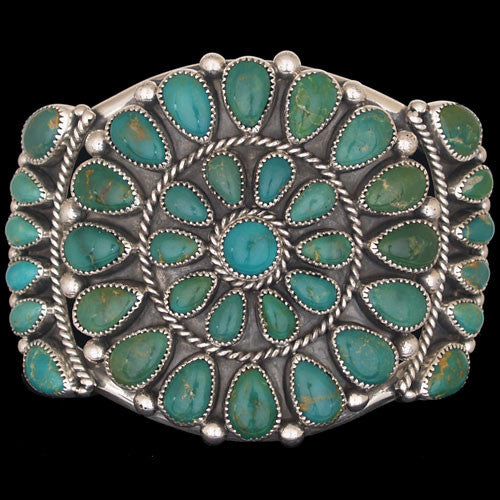
Navajo Natural Gem Grade Stone Mountain Turquoise Cluster Bracelet - Eugene Livingston (#144)
$1,850.00
Artist: Eugene Livingston
Total inner circumference including opening: 6 1/2"
Opening: 1 1/4"
Stone Mountain turquoise is quickly gaining popularity with Navajo silversmiths and turquoise dealers. The best of these stones has all the correct attributes necessary to be labeled "high-grade." Beauty, rarity and durability abound in this turquoise. Other than cutting, shaping and polishing, the stones in this bracelet are completely natural. After sorting the turquoise for color and cutting them into the correct form, Eugene Livingston took the cabochons and placed them in this old-style cluster bracelet. The outcome reflects back on cuffs created in the early days of the art and is amazing.
Stone Mountain Turquoise
Stone Mountain Mine is located in high deserts of Lyon County, Nevada. The mine was discovered in the late 1970's. The majority of the turquoise recovered from this mine is recovered by pick and shovel.
About the artist:

Eugene Livingston - Navajo Jewelry
Eugene is one of those rare artists who has mastered not just one or two methods, but a myriad of jewelry techniques. As a young man, he trained under other talented silversmiths After many decades of steady work, Eugene is skilled at metal fabrication, casting, making his own silver ingots, and most importantly for his work, the ability to cut stones. In his work below, you will see beautiful cut teardrop and pyramid cut Sleeping Beauty turquoise and coral. His two newest pieces with Carico Lake turquoise demonstrate his mastery of silver stamp work.
Related legends:
Silversmith Work
When and how the Navajo acquired the art of working metals is unknown but there are reasons for supposing that it was introduced among them, or at least more developed and improved upon by them, since the time they have occupied their present country?
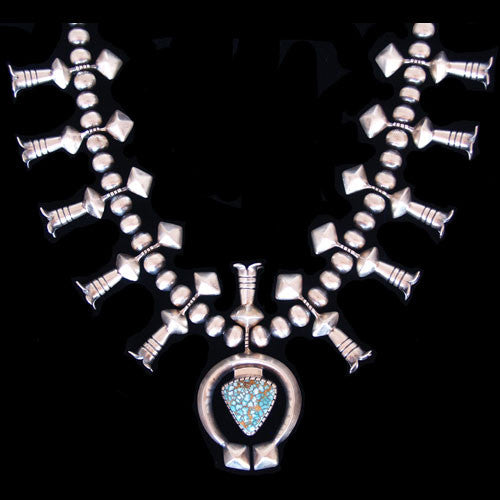
Navajo Squash Blossom #8 Turquoise Necklace - Trent Lee (#01)
$1,800.00
Artist: Trent Lee
Navajo Jewelry
Chain: 24"
Pendant: 1 1/2" x 1 3/4"
Squash blossom necklaces have been an integral part of the Navajo culture a long time, and Allison Lee’s work has been an important part of our collections for a long time. Allison makes some of the best Southwest jewelry you will find. In this case he has located a nice piece of Number 8 turquoise and matched it with his unbeatable silver work. Nice? No, it is much better than that! Spectacular is a more appropriate way to describe this all hand-made piece.
We offer a 100% satisfaction guarantee on every purchase.
Related legends:
Silversmith Work
When and how the Navajo acquired the art of working metals is unknown but there are reasons for supposing that it was introduced among them, or at least more developed and improved upon by them, since the time they have occupied their present country?
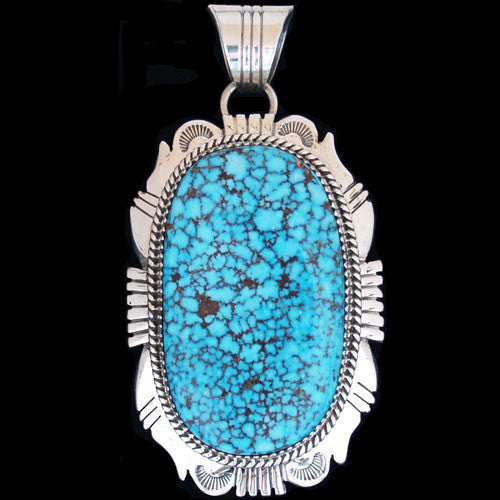
Navajo Natural Gem Grade Spiderweb Kingman Turquoise Pendant - Will Denetdale (#239)
$1,760.00
Artist: Will Denetdale
Navajo Jewelry
1 1/2" x 3"
The Kingman turquoise mine has produced hundreds of thousands of pounds of turquoise since it was first discovered. BUT! If you sorted through that production there would be less than one percent that could match the quality of this stone. Talk about high-grade, the stone in this pendent is totally natural and displays a gorgeous spider-web matrix. Will Denetdale was the obvious choice to set such a spectacular stone, his setting is clean and simple, and shows just enough silver to set-off the unique nature of the turquoise. Superb!
We offer a 100% satisfaction guarantee on every purchase.
Kingman Turquoise
Kingman Turquoise comes from a large open-pit copper mine in the Mineral Park Mining District, northwest of Kingman, Arizona and was one of the largest turquoise mines in this country. The area lies in high desert country at an elevation of 3,345 feet and is surrounded by three mountain ranges. The mining district around Kingman, Arizona has always been a large producer of turquoise, at one time the world's largest. First mined by Indians, this area was home to the most extensive prehistoric workings found in Arizona.
The modern production of turquoise dates back to the early 1880’s when James Haas rediscovered these ancient Kingman area mines. Much of the turquoise occurred as seams, masses and veins. The color of natural Kingman turquoise can range from light blue to very dark blue and sometimes tints of green. The matrix is from white, light brown to black and frequently flecked with pyrite and times quartz. The mine became famous for its rounded, bright blue nuggets with black matrix. Few turquoise mines produced nuggets, especially of this quality. In its high-grade form it has always been considered among the top quality American turquoise. With so many thousands of pounds of good quality turquoise produced in the Kingman area over the last one hundred years it is hard to believe that today very little high-grade Kingman turquoise is available.
Other names for Kingman turquoise: Ithaca Peak, The Wall, Tiffany, Courtland, Az., Gleeson
Most desirable: Deep Blue with molybdenum pyrite; Real blue with pyrite; Bird's eye; Water Web; Nuggets
About the artist:

Will Denetdale - Navajo Jewelry:
One of the most talented Navajo gold and silversmiths currently producing jewelry, Will Denetdale is making an indelible mark in the world of Native American art. His name is becoming famous in his trade; his art a standard by which other pieces may be judged. Will's success as an artist is proportionate to his devotion, and Will Denetdale lives to make jewelry.
Related legends:
Precious Stones
Turquoise; Precious stones have symbolic implications. For example, turquoise if a "collective term for all the precious stones, wealth, or mixed offerings. Good fortune is attributed to this stone." Both white shell and turquoise are emphasized in Kinaalda? More about this legend
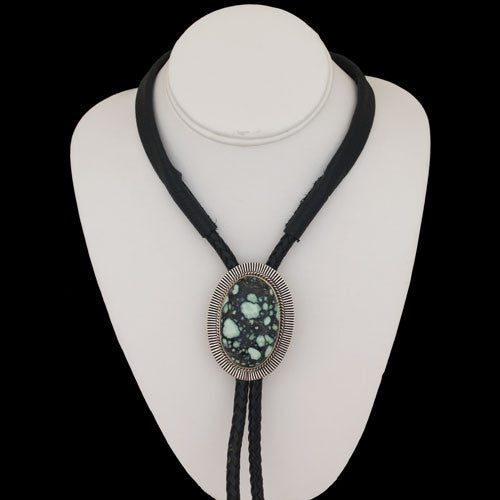
Navajo Sterling Silver Damele Turquoise Bolo Tie - Albert Jake (#62)
$1,695.00
Artist: Albert Jake
Bolo: 1 3/4" x 2 3/8"
Strap: 46" total
This handcrafted sterling silver bolo tie made by Navajo artist Albert Jake reminds us of Easter. Not because of the stunning color, but because this piece of Damele turquoise is as big and large and distinctive as a Faberge egg. Albert has kept the adornment simple to maximize the impact of the stone. Wear this neckpiece and even the Easter Bunny will be green with envy.
Damele Turquoise
Damele turquoise jewelry has become highly collectible mainly due to the character and interest found in this wonderfully distinctive turquoise, which is very hard, and visually appealing. Damele turquoise forms in veins and occasionally as nuggets in carbonaceous chert and also diatomaceous earth. Stones from this mine range in color from pure lime-green through bright chartreuse; yellow with black webbing; white; orange and brown; a caramel color turquoise with bright green polka dots, and small black nuggets with bright yellow-green bumps poking out of the black matrix. Typically the turquoise contains black, brown, or tan matrix but Damele turquoise itself is not typical by any standard.
A small, tightly run operation, the Damele mine is located thirty miles east of Austin, Nevada. The mine is located on The Dry Creek Ranch owned by the Damele family. There, they raise unique horses that carry the Damele name. Benny Damele discovered the mine sometime around 1973. Soon thereafter, Clyde Wright became involved in mining the claim and worked it for approximately eighteen years. Tony Cotner, an excellent miner, merchandiser and truly colorful character, has owned the claim since 1990 when he bought it from Benny Damele. Mr. Cotner, also known as “Mean Green", states there is an ancient subtropical zone located beneath the mine that may be responsible for the unusual colors associated with Damele turquoise although he is unsure whether the organic environment has anything to do with the coloration.
Since Damele turquoise is mined by a character and handled by characters at Twin Rocks Trading Post, it is only natural that we prefer stones chockfull of character as well. The next time you are traveling down U.S. Highway 191 in southern Utah, make sure you stop in and visit our cast of characters. We believe you will greatly enjoy the experience.
Chemical composition of turquoise: CuAl,(PO404(OH)8.4H2O.
About the artist:
Since 1959, Albert Jake has made his home in the beautiful country located about forty miles south of Gallup, New Mexico. He was born at Zuni Pueblo and has resided in the village of Ramah for many years. Albert’s parent taught him the many steps to fine Navajo silverwork which includes both cluster jewelry as well as beautiful stones in classic Navajo settings.
Related legends:
Precious Stones Turquoise; Precious stones have symbolic implications. For example, turquoise if a "collective term for all the precious stones, wealth, or mixed offerings. Good fortune is attributed to this stone." Both white shell and turquoise are emphasized in Kinaalda? More about this legend
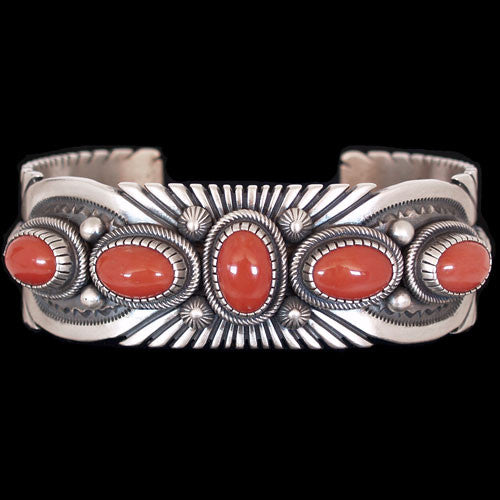
Navajo Heavy Stamped Sterling Silver Red Coral Bracelet - Ray Bennett (#02)
$1,650.00
Artist: Ray Bennett
Navajo Jewelry
Inner Circumference: 5 3/4"
Opening: 1"
Total: 6 3/4"
Width: 1"
Talk about the substantial nature of Navajo jewelry! Ray Bennett has knocked out a bracelet to impress any connoisseur of Native American jewelry. Five extremely well matched cabochons of natural Mediterranean coral grace this piece. Coral was introduced to the Natives of the Great American Southwest back in the 1400s and they have embraced it as their own ever since. Unless you can breathe underwater, do not fall in a lake with this heavyweight on your wrist.
We offer a 100% satisfaction guarantee on every purchase.
Related legends:
Silversmith Work
When and how the Navajo acquired the art of working metals is unknown but there are reasons for supposing that it was introduced among them, or at least more developed and improved upon by them, since the time they have occupied their present country?
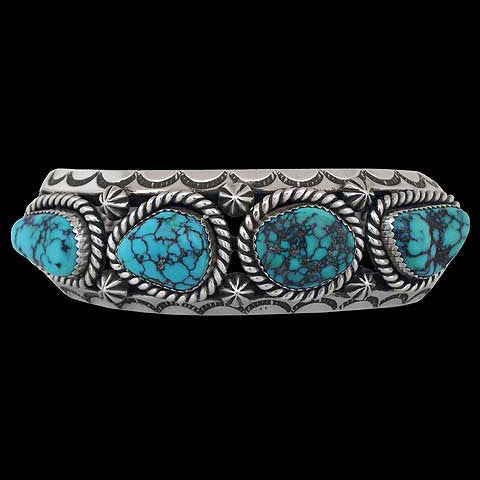
Navajo 4 Stone Turquoise Bracelet - Toby Henderson (#062)
$1,625.00
Artist: Toby Henderson
Navajo Jewelry
Hand Stamped Sterling Silver Bracelet
set with Natural Godber Turquoise and
Natural Burnham Turquoise
Size - 7 1/8
Inner Circumference - 6 1/8"
Opening - 1"
We offer a 100% satisfaction guarantee on every purchase.
About the artist:

Toby Henderson was born and raised in Phoenix, Arizona. The roots of his family tree are buried deep in the Borrego Pass area of the Navajo Reservation in New Mexico. Toby's mother Ella Long, his grandparents, Helen and Jim Long, and his Uncle Phillip Long, and Tommy Long are all silver and gold smiths recognized for high quality and innovative workmanship. Toby learned his art from his grandparents with whom he spent the summer months when he was a young boy. Toby recalls that his Grandparents were patient and inspiring instructors. They were pleased that he was carrying on the family silversmith tradition. Toby's work can be described as both traditional and contemporary, he has a special fondness for hand crafted, three-dimensional, sterling silver kachinas and Yei-be-chei figures. Toby was the first in his family to create these freestanding Holy People figures. With his daughters and son Toby keeps the family tradition alive. The boy and girls help with everything from design to buffing and polishing.
Related legends:
Silversmith Work
When and how the Navajo acquired the art of working metals is unknown but there are reasons for supposing that it was introduced among them, or at least more developed and improved upon by them, since the time they have occupied their present country?
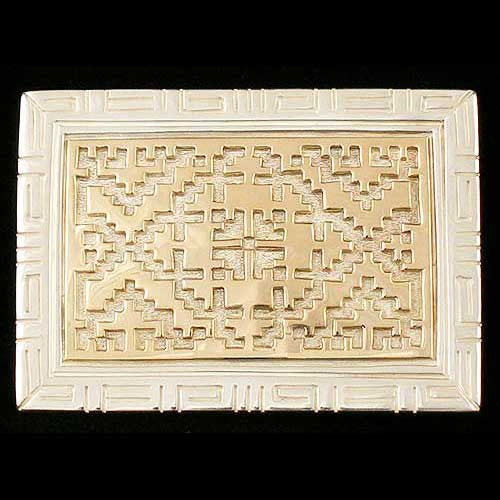
Navajo 14K Gold & Silver Buckle - Ro1bert Taylor (#05)
$1,625.00
Artist: Ro1bert Taylor
Navajo Jewelry
14k Gold & Sterling Silver Buckle
2 7/16" wide x 1 11/16" tall
We offer a 100% satisfaction guarantee on every purchase
About the artist:

Robert Taylor - Silver & Goldsmith:
"Cluster, channel, leaf, inlay, casting... I've done about everything," Robert Taylor talks about his silver and goldsmithing, "There's a lot of artists that do it." And then he confides the reason he has set himself apart from other craftsmen. "I didn't really get anywhere until I decided to design my own style."
Related legends:
Silversmith Work
When and how the Navajo acquired the art of working metals is unknown but there are reasons for supposing that it was introduced among them, or at least more developed and improved upon by them, since the time they have occupied their present country?
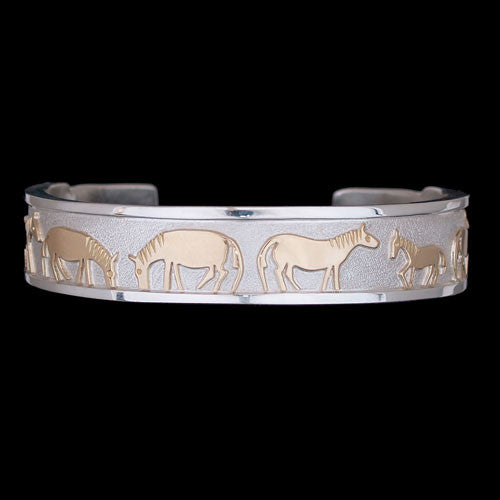
Navajo Sterling Silver w/ 14k Gold Horses Bracelet - Sean Taylor (#01)
$1,495.00
Artist: Sean Taylor
Total inner circumference including opening: 6 1/8"
Opening: 1"
Sean Taylor, the son of Robert Taylor, is extremely fond of horses. So, taking his father’s silversmith style and blending it with a herd of abstract equines, Sean has forged a “wildly” interesting cuff. Sterling silver and 14k gold combine in a pleasing combination. Finish off the design with friendship hands and a spiral for eternity, and you have a terrific bracelet.
Related legends:
Silversmith Work
When and how the Navajo acquired the art of working metals is unknown but there are reasons for supposing that it was introduced among them, or at least more developed and improved upon by them, since the time they have occupied their present country?
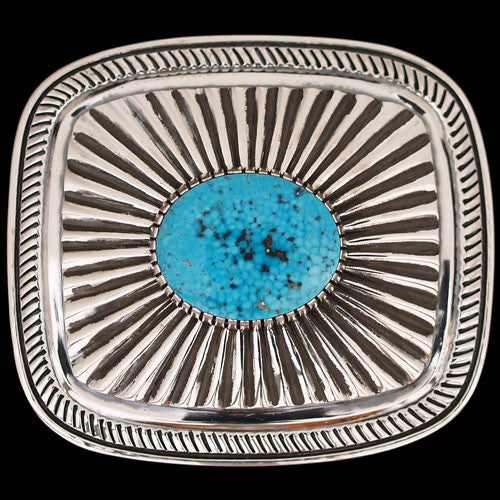
Navajo Morenci Turquoise Buckle - Allison Lee (#169)
$1,485.00
Artist: Allison Lee
Navajo Jewelry
2 1/2" x 2 1/4"
Allison Lee is surely one of the finest contemporary Navajo silversmiths working in the Southwest, likely the country. This immaculately conceived and exquisitely executed buckle shows off Allison’s skill. Wear this one dressed up or dressed down, just wear it. You will never be sorry you did.
We offer a 100% satisfaction guarantee on every purchase.
Morenci Turquoise
Morenci Turquoise; Arizona Mine, Morenci, Clifton-Morenci District, Shannon Mountains, Greenlee County, Arizona, USA. An open pit copper mine located in the N1⁄2 Section 16, T4S, R29E (Clifton 15 minute topographic map), owned by Phelps Dodge Corp. Map Reference: 33°5'26"N, 109°21'58"W.
Morenci turquoise was mined in southeastern Arizona until approximately 1990. It is located very near the New Mexico border, and ranges in color from classic high electric blue to light azure. Prehistoric Indians who valued the stone for its deep blue color were the first to discover the deposit. These people adorned themselves with rough-hewn beads and carved talisman made from the mineral
Morenci is often associated with an unusual black matrix of irregular iron pyrite, which looks metallic when polished. Although they are rare, stones with unusual birds-eye patterns, red matrix and an occasional layer of silver have also been found. The Morenci name is derived from the large open pit copper mine owned and operated by the Phelps Dodge Corporation. Early examples of this striking turquoise were of the "lunch box" variety, meaning workers and miners carried them out of the mine.
Morenci is well known; it was one of the first types of American turquoise to find its way to the market and is always difficult to obtain because the mine was depleted so long ago. It is believed that the best Morenci ever produced was discovered in the late 1960's to early 70's. During this time period, the mine produced a high, electric blue variety with iron pyrite inclusions. Since Morenci is no longer being mined, and because of its striking color and unusual matrix combinations, high grade natural Morenci is a valuable, highly collectible mineral.
USGS; Arizona.--In Arizona turquoise ranks first in terms of value of production and is also the best known of its gem materials. Nearly all-important deposits of turquoise are located near copper occurrences or in copper deposits in arid desert regions of the world. Thus, the world famous turquoise deposits associated with certain of the large Arizona copper deposits are to be expected.
Turquoise is, or has been, mined from a number of these copper mines as a byproduct, usually by outside contractors. The financial and operating terms of the collecting contracts vary from mine to mine. Some of the operations are little more than the efforts of individual commercial collectors; some are essentially full-scale mining operations that are simultaneous with, but separate from, the regular mining operations; and still others operate on an on-call basis as turquoise is uncovered by the regular copper mining operation. Regardless of the size or sophistication of the initial mining or recovery operation, the actual turquoise is recovered by careful extraction using hand method.
About the artist:

Allison Lee - Navajo Silversmith:
Speaking of the silver and gold jewelry he hand crafts, Allison Lee's captivating voice is sincere when he says, "One time my uncle told me that everything we build comes from the earth, like the silver that comes from the earth, or the turquoise that comes from the earth. That is a lot of energy. You put it together and you put your heart and mind into a piece. Then sometimes a certain piece of jewelry- I believe- it is made for a certain person. I usually have a ring, or something, that stays with me for about two or three years, until the right person comes along. And then that person buys that piece. I believe that every piece of jewelry that I make is made for somebody out there- it's made for somebody special. Whoever might be having problems, or something like that. In essence, that energy helps that person get help, by wearing pieces that we make. That is the way I look at it.
Related legends:
Precious Stones
Turquoise; Precious stones have symbolic implications. For example, turquoise if a "collective term for all the precious stones, wealth, or mixed offerings. Good fortune is attributed to this stone." Both white shell and turquoise are emphasized in Kinaalda? More about this legend
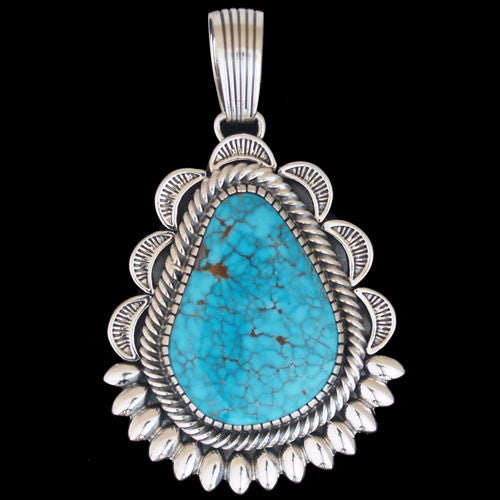
Navajo Natural Gem Grade Morenci Water-web Turquoise Pendant - Allison Lee (#184)
$1,475.00
Artist: Allison Lee
1 3/4" x 2 3/4"
Because Allison Snowhawk Lee is such a fine craftsman, he is often given access to the most precious stones. Super high-grade natural water-web Morenci turquoise is an example of such specimens, and when presented in a hand-fabricated setting by this master silversmith it becomes even dearer. Compare this stone and its setting to anything you have ever seen and you will have a benchmark for quality. Enough said.
Morenci Turquoise
Morenci Turquoise; Arizona Mine, Morenci, Clifton-Morenci District, Shannon Mountains, Greenlee County, Arizona, USA. An open pit copper mine located in the N1⁄2 Section 16, T4S, R29E (Clifton 15 minute topographic map), owned by Phelps Dodge Corp. Map Reference: 33°5'26"N, 109°21'58"W.
Morenci turquoise was mined in southeastern Arizona until approximately 1990. It is located very near the New Mexico border, and ranges in color from classic high electric blue to light azure. Prehistoric Indians who valued the stone for its deep blue color were the first to discover the deposit. These people adorned themselves with rough-hewn beads and carved talisman made from the mineral
Morenci is often associated with an unusual black matrix of irregular iron pyrite, which looks metallic when polished. Although they are rare, stones with unusual birds-eye patterns, red matrix and an occasional layer of silver have also been found. The Morenci name is derived from the large open pit copper mine owned and operated by the Phelps Dodge Corporation. Early examples of this striking turquoise were of the "lunch box" variety, meaning workers and miners carried them out of the mine.
Morenci is well known; it was one of the first types of American turquoise to find its way to the market and is always difficult to obtain because the mine was depleted so long ago. It is believed that the best Morenci ever produced was discovered in the late 1960's to early 70's. During this time period, the mine produced a high, electric blue variety with iron pyrite inclusions. Since Morenci is no longer being mined, and because of its striking color and unusual matrix combinations, high grade natural Morenci is a valuable, highly collectible mineral.
USGS; Arizona.--In Arizona turquoise ranks first in terms of value of production and is also the best known of its gem materials. Nearly all-important deposits of turquoise are located near copper occurrences or in copper deposits in arid desert regions of the world. Thus, the world famous turquoise deposits associated with certain of the large Arizona copper deposits are to be expected.
Turquoise is, or has been, mined from a number of these copper mines as a byproduct, usually by outside contractors. The financial and operating terms of the collecting contracts vary from mine to mine. Some of the operations are little more than the efforts of individual commercial collectors; some are essentially full-scale mining operations that are simultaneous with, but separate from, the regular mining operations; and still others operate on an on-call basis as turquoise is uncovered by the regular copper mining operation. Regardless of the size or sophistication of the initial mining or recovery operation, the actual turquoise is recovered by careful extraction using hand method.
About the artist:

Allison Lee - Navajo Silversmith:
Speaking of the silver and gold jewelry he hand crafts, Allison Lee's captivating voice is sincere when he says, "One time my uncle told me that everything we build comes from the earth, like the silver that comes from the earth, or the turquoise that comes from the earth. That is a lot of energy. You put it together and you put your heart and mind into a piece. Then sometimes a certain piece of jewelry- I believe- it is made for a certain person. I usually have a ring, or something, that stays with me for about two or three years, until the right person comes along. And then that person buys that piece. I believe that every piece of jewelry that I make is made for somebody out there- it's made for somebody special. Whoever might be having problems, or something like that. In essence, that energy helps that person get help, by wearing pieces that we make. That is the way I look at it.
Related legends:
Silversmith Work
When and how the Navajo acquired the art of working metals is unknown but there are reasons for supposing that it was introduced among them, or at least more developed and improved upon by them, since the time they have occupied their present country?
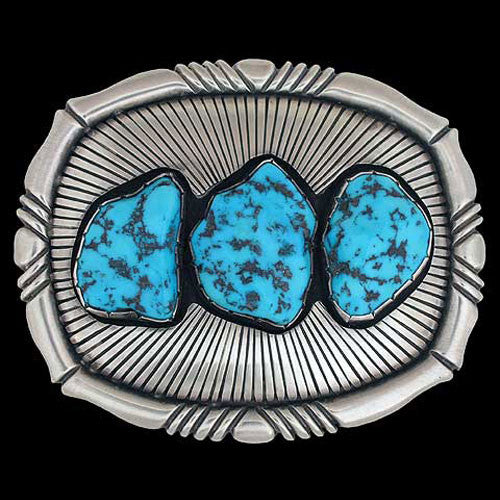
Navajo Sterling Silver & Sleeping Beauty Turquoise Buckle - Calvin Martinez (#01)
$1,350.00
Artist: Calvin Martinez
Navajo Jewelry
3 5/8" x 3 1/8"
Center Stone: 1" x 1 3/8"
As our dear old Daddy is fond of saying: "You can see that buckle coming like a headlight on a freight train." Calvin Martinez is noted for his heavy-duty silver work and his love of bright, colorful turquoise. In this case he chose a threesome of some stunning high-grade natural turquoise from the Sleeping Beauty Mountains of Globe, Arizona. Cut in the nugget style, these stones standout. Calvin built this buckle to withstand the test of time; it will be causing a commotion for a long time to come.
We offer a 100% satisfaction guarantee on every purchase.
Sleeping Beauty Turquoise
The Sleeping Beauty turquoise mine is located seven miles from Globe, Arizona. The mine is one of the largest producers of turquoise in North America. The mine, and the turquoise extracted from it, derives its name from Sleeping Beauty Mountain, which at one time was part of the Copper Cities operation. The center of the copper mine is located at approximately 33o24"13.23"N. 110o53'34. 60"W, at an elevation of 1224 feet. Sleeping Beauty Turquoise Mining is presently owned and operated by Monty Nichols.
For many centuries before the first Europeans made their way into Arizona, turquoise was being mined on the slopes of Sleeping Beauty Mountain. The Salado and other ancient peoples mined the beautiful sky stone from several surface outcroppings located in the vicinity, including Pinto Valley. It is believed that Spanish explorers were the first Europeans to locate the source of Sleeping Beauty sometime around the 1860s. By the 1870s, small underground mines pockmarked the hills surrounding present day Globe.
Cities Service Company started the Copper Cities Mine (commonly called the Sleeping Beauty Mine) in 1952 and operated it until the Pinto Valley mine opened in 1972. During the 1960s, L.W. Hardy had the contract to mine turquoise, both at Sleeping Beauty and at Castle Dome, later called the Pinto Valley Mine. Formerly a meat cutter at a market in Miami, Hardy recognized early on that turquoise was more valuable as a gemstone than the associated copper.
By the time the turquoise boom began, Hardy had contracts with mining companies in Miami, Kingman and elsewhere. He also developed a method for stabilizing low-grade, porous turquoise with pressure-impregnated hot acrylic resin, which hardened the stone and improved the color.
Hardy's mining methods were primitive when compared with current operations. Hardy's workers sat in a ditch ripped by a bulldozer and hand picked the stone from waste-rock. Hardy mined turquoise at Sleeping Beauty for 22 years, getting about 45 percent recovery, and leaving the rest in waste dumps.
Monty Nichols received the contract to mine Sleeping Beauty turquoise in 1988, and began using modern mining methods to develop the property. Nichols drills and blasts the overburden, hauling it to the abandoned Copper Cities pit, which now contains the recycled tailings from Miami Copper Company's No. 5 tailing dam. The old dam dominated the eastern skyline of downtown Miami until recently. The year Nichols acquired the contract; he began a two-year project to remove 5,000.000 tons of overburden. Located half way up the side of an open pit mine, the narrow turquoise-bearing zone has about 400 feet of hard waste rock on top of it. In order to move sideways into the ore-body, a whole slice of the mountain had to be removed.
To avoid fracturing the turquoise, Nichols was careful not to blast too near the turquoise-bearing strata. That layer is more crumbly, so the miners can rip it and dump it over screens, separating the material by size. No crushers are used, again to avoid fracturing the gemstone, and the different sized rock is hauled up to a wide mine bench where conveyor belts move the material through three buildings. There, workers handpick turquoise from the broken rock. The buildings are vented with filtered air to eliminate workers' exposure to dust, and well insulated to keep them comfortable in any weather. It is a far cry from the old methods of mining. Anywhere from 30 to 40 people work at the mine at any one time, depending on how much mining there is to do.
Fifty years ago, mine workers filled lunch buckets with the colorful rock, even though it was reason for immediate termination. Old habits die hard, and some people still think it is okay to sneak in and try to pick turquoise. As a result, security is tight in and around the mine. Motion detectors, night vision cameras and 24/7 roving patrols are used, so the only turquoise leaving the property now is being shipped to markets around the world.
Italy is the largest volume buyer of Sleeping Beauty turquoise, with Germany and Hong Kong following closely behind. These customers buy the best grade for their exclusive jewelry. Jewelry makers in India and Spain also receive Sleeping Beauty turquoise, while in the U.S., Gallup and Albuquerque are the largest consumers.
The Sleeping Beauty turquoise mine produces a uniform light to medium blue turquoise with rare finds of deep, dark blue. Because of its uniformity, it has been a favorite of the Zuni Pueblo. Zuni silversmiths often use it in channel inlay and various types of cluster work that require large numbers of small, perfectly matched stones. The Sleeping Beauty mine has been one of the larger producers of rough turquoise in the United States, although today much less good turquoise is being produced than in the past.
Sleeping Beauty turquoise is noted for its solid, light blue color with no matrix; the host rock is usually granite. Nichols says the mine is producing about 1,600 pounds a month. Of that, only four percent is natural; most of the turquoise from the mine is altered in some way. Most is enhanced, which is more expensive than stabilization, and sold to large distributors in this country and Europe. Currently most of the turquoise that comes from the mine is from the tons of tailings piles that have been accumulating for decades.
The best of the Sleeping Beauty turquoise is comparable to that found in the Middle East. It is thought that large quantities of Sleeping Beauty turquoise is taken overseas and smuggled into, then out of, Iran to be sold as “Persian” turquoise.
Related legends:
Silversmith Work
When and how the Navajo acquired the art of working metals is unknown but there are reasons for supposing that it was introduced among them, or at least more developed and improved upon by them, since the time they have occupied their present country?
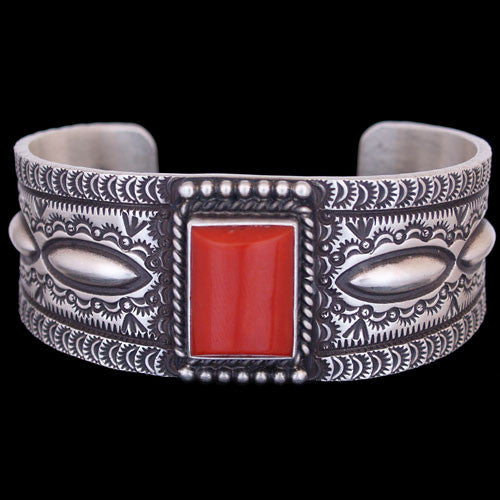
Navajo Handmade Sterling Silver Mediteranean Coral Bracelet - Herman Smith (#02)
$1,250.00
Artist: Herman Smith
Total inner circumference including opening: 6 3/8"
Opening: 1 1/8"
Barry recently negotiated Herman Smith’s wife out of her Mediterranean, blood-red coral bracelet. Barry was so fond of the deep and precise stamping and the great stone, he couldn’t let it go. Herman assured his wife and Barry there would be another forthcoming to maintain martial harmony. The trading post therefore is the owner of another beautiful bracelet.
About the artist:

Related legends:
Silversmith Work
When and how the Navajo acquired the art of working metals is unknown but there are reasons for supposing that it was introduced among them, or at least more developed and improved upon by them, since the time they have occupied their present country?
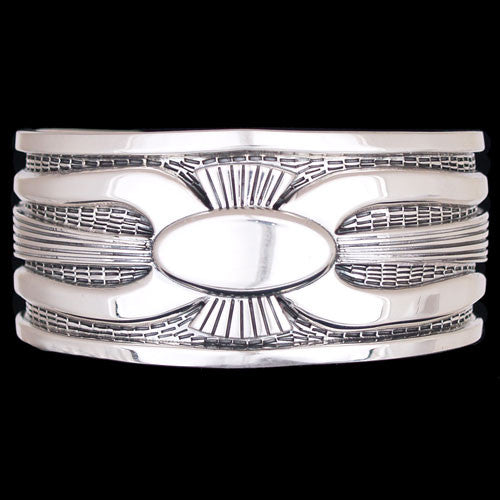
Navajo Sterling Silver Ketoh "Bow Guard" Design Bracelet - Allison Lee (#176)
$1,250.00
Artist: Allison Lee
Navajo Jewelry
Inner Cumference: 5 1/4"
Opening: 1"
Total: 6 1/4"
The ketoh or bow guard design is one of the classic motifs of Navajo art. Master craftsman Allison Lee has taken his inspiration for that tradition and made a bracelet of stunning simplicity and beauty. That, however, is par for the course with Allison.
We offer a 100% satisfaction guarantee on every purchase.
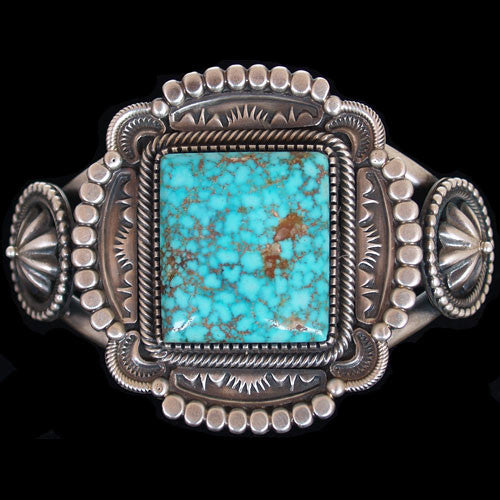
Navajo Waterweb Kingman Turquoise Bracelet - Ray Bennett (#01)
$1,250.00
Artist: Ray Bennett
Navajo Jewelry
Inner Circumference: 5 1/4"
Opening: 1"
Total: 6 1/4"
Width: 2" x 1 3/4"
You can almost hear the “snap” when an artist matches a great stone with crisp silver work. In this particular bracelet, Navajo silversmith Ray Bennett has located a super piece of Water web Kingman turquoise and then built an amazing setting to showcase the stone. Maybe it should be “snap, crackle, pop”.
We offer a 100% satisfaction guarantee on every purchase.
Kingman Turquoise
Kingman Turquoise comes from a large open-pit copper mine in the Mineral Park Mining District, northwest of Kingman, Arizona and was one of the largest turquoise mines in this country. The area lies in high desert country at an elevation of 3,345 feet and is surrounded by three mountain ranges. The mining district around Kingman, Arizona has always been a large producer of turquoise, at one time the world's largest. First mined by Indians, this area was home to the most extensive prehistoric workings found in Arizona.
The modern production of turquoise dates back to the early 1880πs when James Haas rediscovered these ancient Kingman area mines. Much of the turquoise occurred as seams, masses and veins. The color of natural Kingman turquoise can range from light blue to very dark blue and sometimes tints of green. The matrix is from white, light brown to black and frequently flecked with pyrite and times quartz. The mine became famous for its rounded, bright blue nuggets with black matrix. Few turquoise mines produced nuggets, especially of this quality. In its high-grade form it has always been considered among the top quality American turquoise. With so many thousands of pounds of good quality turquoise produced in the Kingman area over the last one hundred years it is hard to believe that today very little high-grade Kingman turquoise is available.
Other names for Kingman turquoise: Ithaca Peak, The Wall, Tiffany, Courtland, Az., Gleeson
Most desirable: Deep Blue with molybdenum pyrite; Real blue with pyrite; Bird's eye; Water Web; Nuggets
Related legends:
Precious Stones
Turquoise; Precious stones have symbolic implications. For example, turquoise if a "collective term for all the precious stones, wealth, or mixed offerings. Good fortune is attributed to this stone." Both white shell and turquoise are emphasized in Kinaalda? More about this legend
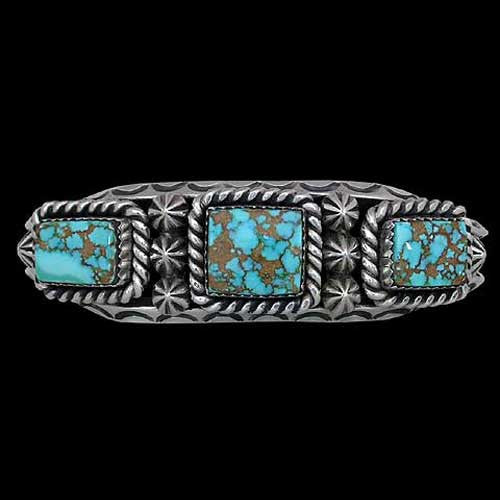
Three Stone Paiute Turquoise Bracelet - Toby Henderson (#063)
$1,250.00
Artist: Toby Henderson
Navajo Silver and Turquoise Jewelry
Hand Stamped Sterling Silver Bracelet
set with Natural Paiute Turquoise
Size - 6 3/4
Opening - 1"
Inner Circumference - 5 3/4"
We offer a 100% satisfaction guarantee on every purchase.
The Paiute turquoise mine consists of a series of nine full claims that run along the southern and western portion of a rock-strewn and sage brush encrusted central Nevada hillside. Down the southern slope and to the southwest about a half mile, nestled in a small valley dotted with juniper trees, is the Damele mine.
Paiute turquoise forms in veins and occasionally as nuggets in carbonaceous chert and diatomaceous earth. Since it is relatively new to the market, Paiute is a less well known stone. Because of the high quality turquoise the mine produces, however, it will certainly become a strong contender in the contemporary market. Paiute turquoise ranges in color from powder blue with yellow matrix to an intense, electric blue with fine black spider-web matrix. Unique pastel blue turquoise with white polka dots and blue-greens with dark matrix patterns are also found. Paiute turquoise is rare and strikingly beautiful; it has one of the most wide ranging color palates and matrix variables of any known turquoise.
A small, tightly run operation, the Paiute mine is located near Austin, Nevada. Clyde Wright initially staked the Paiute claim in 1975. Wright lightly worked the mine for a few years, but had turquoise claims all over the Nevada countryside and seems to have been spread very thin. Tony Cotner, an excellent miner, merchandiser and truly colorful character has owned the claims since 1992, when he bought them from Clyde's estate. Mr. Cotner, is also known as"Mean Green".
About the artist:

Toby Henderson was born and raised in Phoenix, Arizona. The roots of his family tree are buried deep in the Borrego Pass area of the Navajo Reservation in New Mexico. Toby's mother Ella Long, his grandparents, Helen and Jim Long, and his Uncle Phillip Long, and Tommy Long are all silver and gold smiths recognized for high quality and innovative workmanship. Toby learned his art from his grandparents with whom he spent the summer months when he was a young boy. Toby recalls that his Grandparents were patient and inspiring instructors. They were pleased that he was carrying on the family silversmith tradition. Toby's work can be described as both traditional and contemporary, he has a special fondness for hand crafted, three-dimensional, sterling silver kachinas and Yei-be-chei figures. Toby was the first in his family to create these freestanding Holy People figures. With his daughters and son Toby keeps the family tradition alive. The boy and girls help with everything from design to buffing and polishing.
Related legends:
Silversmith Work
When and how the Navajo acquired the art of working metals is unknown but there are reasons for supposing that it was introduced among them, or at least more developed and improved upon by them, since the time they have occupied their present country?
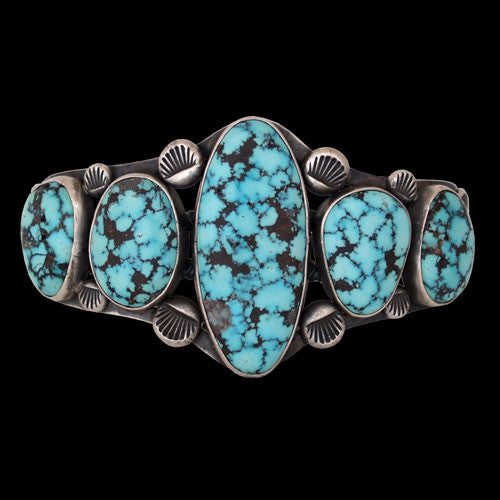
China Mountain Turquoise Bracelet - Harold Becenti (#04)
$1,225.00
Artist: Harold Becenti
Navajo Silver Jewelry
China Mountain Turquoise
set in Sterling Silver Bracelet
Size - 6 1/4
Inner Circumference - 5 1/8"
Opening - 1 1/8"
Harold Bicenti has a way with Skystone and silver. He hand fashions and crafts attractive objects of wearable art from rare and valuable elements of the Earth herself. Sterling silver and turquoise jewelry has been loved and cherished by the Navajo people since Spanish silversmiths first taught them how to set their precious turquoise into its warm embrace. Harold has found an extremely nice suite of China Mountain Turquoise and lent his considerable talent to crafting a most wonderfully traditional style wrist band.
We offer a 100% satisfaction guarantee on every purchase.
About the artist:

Harold Becenti derives from Little Water, New Mexico, a small Navajo enclave in northwestern New Mexico. He was born in 1964, but did not acquire his smithing skills until in his twenties, learning from his mother, Emma Bighand, as well as a girlfriend, Harold has developed a classic style of heavy silver jewelry featuring deep, precise stampwork and natural turquoise stones.
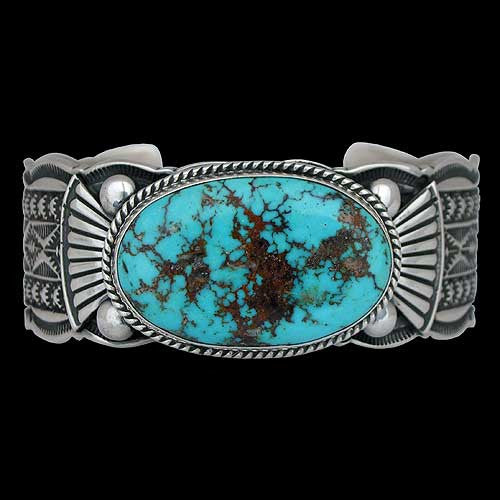
Navajo Burnham Turquoise Bracelet - Guy Haskie (#018)
$1,220.00
Artist: Guy Haskie
Navajo Jewelry
Hand Stamped Sterling Silver Cuff Bracelet set with Natural, Gem Grade Burnham Turquoise
Size - 6 5/8
Inner Circumference - 5 5/8"
Opening - 1"
Like the intricate pattern of a diamondback rattlesnake, the design on this Guy Haskie bracelet is mesmerizing. Intricate stamping sets off a beautiful and large natural, gem grade Burnham turquoise stone. Guy is well known for his silver smithing talents and has used them to great effect in this stunning cuff. This is a piece that will make any turquoise jewelry lover happy.
We offer a 100% satisfaction guarantee on every purchase.
Related legends:
Silversmith Work
When and how the Navajo acquired the art of working metals is unknown but there are reasons for supposing that it was introduced among them, or at least more developed and improved upon by them, since the time they have occupied their present country?
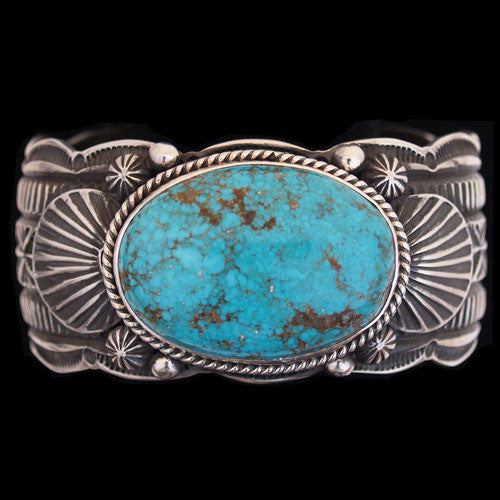
Navajo Burnham Turquoise Bracelet - Guy Haskie (#20)
$1,200.00
Artist: Guy Haskie
Navajo Jewelry
Total Circumference: 6 1/4"
Inner Circumference: 5 1/4"
Opening: 1"
Guy Haskie is known for his deeply precise and precisely deep silver stamping and his choice of topnotch stones. In this bracelet, Guy has placed a monster cabochon of blue-green Burnham turquoise on a hand-stamped shank and brought us a bracelet anyone with an eye for fashion will be proud to own and wear.
We offer a 100% satisfaction guarantee on every purchase.
Related legends:
Precious Stones
Turquoise; Precious stones have symbolic implications. For example, turquoise if a "collective term for all the precious stones, wealth, or mixed offerings. Good fortune is attributed to this stone." Both white shell and turquoise are emphasized in Kinaalda? More about this legend
Certificate of Authenticity
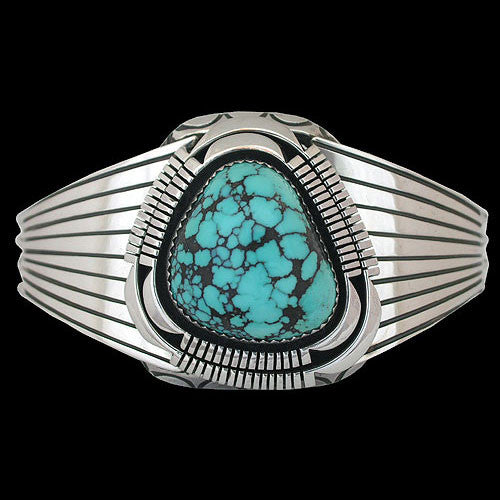
Navajo Overlay Bracelet with Burnham Turquoise - Toby Henderson (#076)
$1,200.00
Artist: Toby Henderson
Navajo Jewelry
Hand Stamped Sterling Silver Overlay Bracelet set with Natural Burnham Turquoise
Size - 7 3/4
Inner Circumference - 5 7/8"
Opening - 1 7/8"
Stone - 3/4" wide x 1" tall
We offer a 100% satisfaction guarantee on every purchase.
About the artist:

Toby Henderson was born and raised in Phoenix, Arizona. The roots of his family tree are buried deep in the Borrego Pass area of the Navajo Reservation in New Mexico. Toby's mother Ella Long, his grandparents, Helen and Jim Long, and his Uncle Phillip Long, and Tommy Long are all silver and gold smiths recognized for high quality and innovative workmanship. Toby learned his art from his grandparents with whom he spent the summer months when he was a young boy. Toby recalls that his Grandparents were patient and inspiring instructors. They were pleased that he was carrying on the family silversmith tradition. Toby's work can be described as both traditional and contemporary, he has a special fondness for hand crafted, three-dimensional, sterling silver kachinas and Yei-be-chei figures. Toby was the first in his family to create these freestanding Holy People figures. With his daughters and son Toby keeps the family tradition alive. The boy and girls help with everything from design to buffing and polishing.
Related legends:
Silversmith Work
When and how the Navajo acquired the art of working metals is unknown but there are reasons for supposing that it was introduced among them, or at least more developed and improved upon by them, since the time they have occupied their present country?
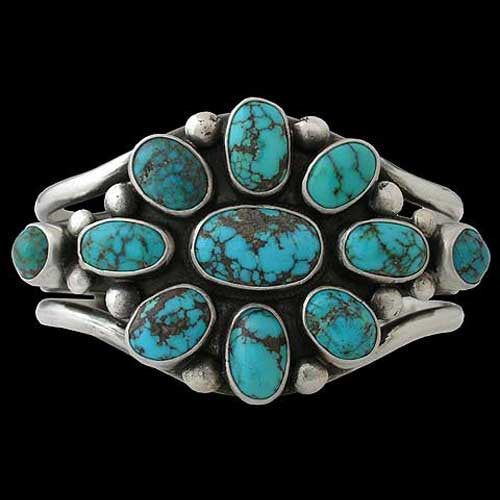
Navajo Multi Stone Persian Turquoise Bracelet - Verdy Jake (#019)
$1,200.00
Artist: Verdy Jake
Navajo Jewelry
Sterling Silver Bracelet Set with Natural Persian Turquoise
Size - 6 7/8
Inner Circumference - 5 3/8"
Opening - 1 1/2"
Center Stone - 3/8" tall x 3/4" wide
We offer a 100% satisfaction guarantee on every purchase.
Related legends:
Silversmith Work
When and how the Navajo acquired the art of working metals is unknown but there are reasons for supposing that it was introduced among them, or at least more developed and improved upon by them, since the time they have occupied their present country?
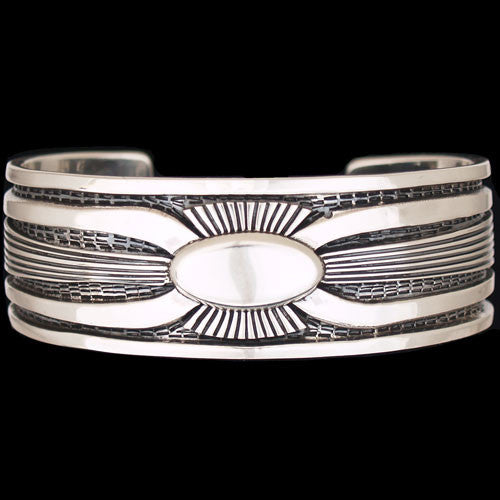
Navajo Ketoh Design Sterling Silver Bracelet - Allison Lee (#181)
$1,150.00
Artist: Allison Lee
Total Inner Circumference including opening: 7 1/2"
Opening: 1 1/4"
About the artist:

Allison Lee - Navajo Silversmith:
Speaking of the silver and gold jewelry he hand crafts, Allison Lee's captivating voice is sincere when he says, "One time my uncle told me that everything we build comes from the earth, like the silver that comes from the earth, or the turquoise that comes from the earth. That is a lot of energy. You put it together and you put your heart and mind into a piece. Then sometimes a certain piece of jewelry- I believe- it is made for a certain person. I usually have a ring, or something, that stays with me for about two or three years, until the right person comes along. And then that person buys that piece. I believe that every piece of jewelry that I make is made for somebody out there- it's made for somebody special. Whoever might be having problems, or something like that. In essence, that energy helps that person get help, by wearing pieces that we make. That is the way I look at it.
Related legends:
Silversmith Work
When and how the Navajo acquired the art of working metals is unknown but there are reasons for supposing that it was introduced among them, or at least more developed and improved upon by them, since the time they have occupied their present country?
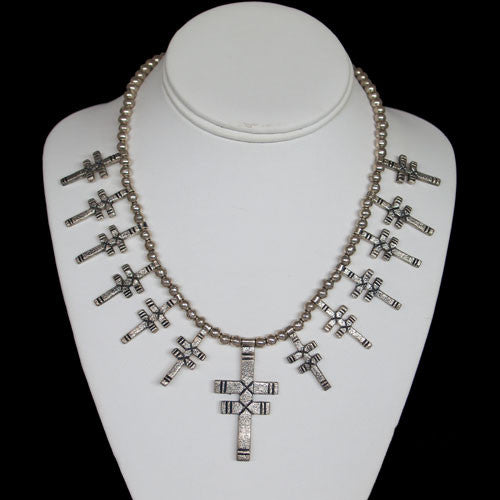
Navajo Tufa Cast Dragonfly Cross Necklace - Harrison Jim (#06)
$1,140.00
Artist: Harrison Jim
17 1/4" long
Spanish artisans first introduced the Navajo people to silversmith work and the pattern of the cross. Since that time the cross has been one of the most recreated designs in Navajo art. Harrison Jim mastered the art of casting designs in tufa stone years ago and does it very well. By using the widely accepted symbol of the double cross, Harrison has created a necklace to honor tradition and culture that spans the ages.
Related legends:
Silversmith Work
When and how the Navajo acquired the art of working metals is unknown but there are reasons for supposing that it was introduced among them, or at least more developed and improved upon by them, since the time they have occupied their present country?
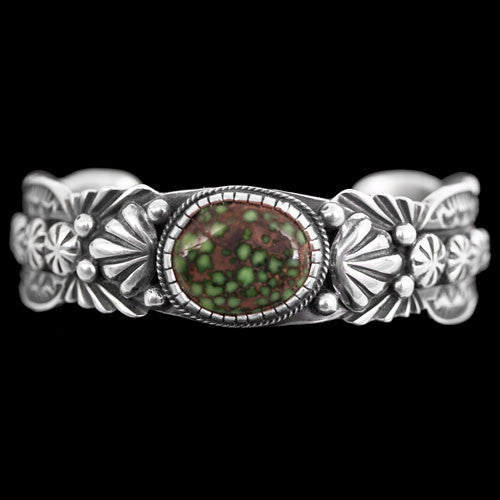
Navajo Damele Turquoise Bracelet - Victor Begay (#31)
$1,125.00
Artist: Victor Begay
Navajo Jewelry
Inner Circumference: 5 1/4"
Opening: 1 1/4"
Total: 6 1/2"
Width: 3/4"
Wow, now this is one beautiful bracelet. Navajo silversmith Victor Begay has stamped, filed and hammered sterling silver into a bracelet that people will admire for ages. Adding a spectacular piece of Natural Gem Grade Damele turquoise, he finished this cuff perfectly. It is rare indeed that we see such a finely conceived and executed bracelet. Order soon, this one won’t last.
We offer a 100% satisfaction guarantee on every purchase.
Damele Turquoise
Damele turquoise jewelry has become highly collectible mainly due to the character and interest found in this wonderfully distinctive turquoise, which is very hard, and visually appealing. Damele turquoise forms in veins and occasionally as nuggets in carbonaceous chert and also diatomaceous earth. Stones from this mine range in color from pure lime-green through bright chartreuse; yellow with black webbing; white; orange and brown; a caramel color turquoise with bright green polka dots, and small black nuggets with bright yellow-green bumps poking out of the black matrix. Typically the turquoise contains black, brown, or tan matrix but Damele turquoise itself is not typical by any standard.
A small, tightly run operation, the Damele mine is located thirty miles east of Austin, Nevada. The mine is located on The Dry Creek Ranch owned by the Damele family. There, they raise unique horses that carry the Damele name. Benny Damele discovered the mine sometime around 1973. Soon thereafter, Clyde Wright became involved in mining the claim and worked it for approximately eighteen years. Tony Cotner, an excellent miner, merchandiser and truly colorful character, has owned the claim since 1990 when he bought it from Benny Damele. Mr. Cotner, also known as “Mean Green", states there is an ancient subtropical zone located beneath the mine that may be responsible for the unusual colors associated with Damele turquoise although he is unsure whether the organic environment has anything to do with the coloration.
Since Damele turquoise is mined by a character and handled by characters at Twin Rocks Trading Post, it is only natural that we prefer stones chockfull of character as well. The next time you are traveling down U.S. Highway 191 in southern Utah, make sure you stop in and visit our cast of characters. We believe you will greatly enjoy the experience.
Chemical composition of turquoise: CuAl,(PO404(OH)8.4H2O.
Related legends:
Silversmith Work
When and how the Navajo acquired the art of working metals is unknown but there are reasons for supposing that it was introduced among them, or at least more developed and improved upon by them, since the time they have occupied their present country?
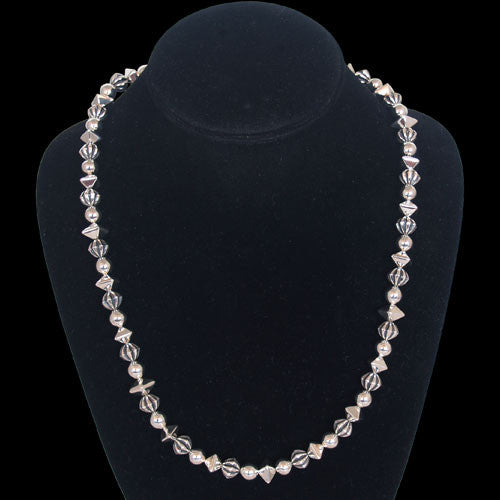
Navajo Handmade Sterling Silver Bead Necklace - Trent Lee (#06)
$1,100.00
Artist: Trent Lee
Trent Lee is taking the art of making "Navajo pearls" to an entirely new level. Not only does he create unique shapes, his finish detail is over the top. Trent learned the art from his father, Allison Snowhawk Lee, and they still work together in the same shop. Handmade beads are difficult to create, since there are numerous steps involved in each individual pearl and not many artists have the patience and attention to detail to work through the process. Luckily Trent does.
Related legends:
Silversmith Work
When and how the Navajo acquired the art of working metals is unknown but there are reasons for supposing that it was introduced among them, or at least more developed and improved upon by them, since the time they have occupied their present country?
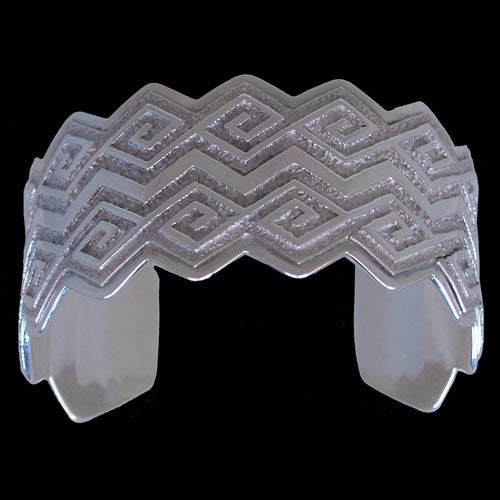
Navajo Sterling Silver Twin Falls Bracelet - Ray Scott (#02)
$1,100.00
Artist: Ray Scott
Navajo Jewelry
Size: 6 1/2
Inner Circumference: 5 1/4"
Opening: 1 1/4"
Navajo artist Ray Scott titled this water inspired bracelet "Twin Falls". This free flowing wrist band is hand fabricated of sterling silver and is reminiscent of the life giving liquid so essential to regeneration and proliferation on this semi-arid landscape. Moisture is a must when you are gifted a mere six inches annually. Ray is inspired by the forces of nature and we benefit greatly from those revealing revelations.
We offer a 100% satisfaction guarantee on every purchase.
Related legends:
Silversmith Work
When and how the Navajo acquired the art of working metals is unknown but there are reasons for supposing that it was introduced among them, or at least more developed and improved upon by them, since the time they have occupied their present country?
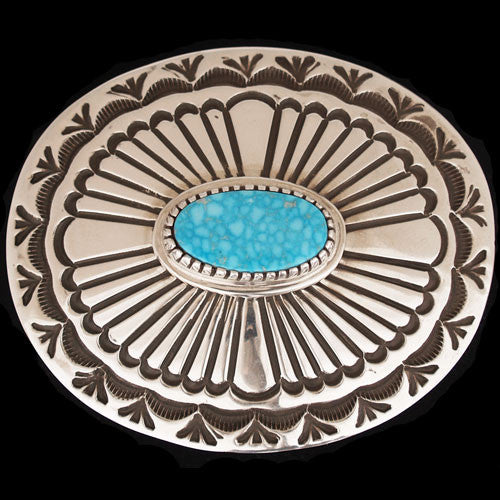
Navajo Sterling Silver and Kingman Waterweb Turquoise Buckle - Tommy Jackson (#39)
$990.00
Artist: Tommy Jackson
Navajo Jewelry
2 3/4" x 2 1/4"
Tommy Jackson often arrives at the trading post on his Harley-Davidson iron horse motorcycle. Once he lands in the parking lot, we are eager to see what he carries in his saddlebags. In this case it was a nicely stamped oval buckle with a beautiful piece of water web turquoise from Kingman, Arizona. Ride on.
We offer a 100% satisfaction guarantee on every purchase.
Kingman Turquoise
Kingman Turquoise comes from a large open-pit copper mine in the Mineral Park Mining District, northwest of Kingman, Arizona and was one of the largest turquoise mines in this country. The area lies in high desert country at an elevation of 3,345 feet and is surrounded by three mountain ranges. The mining district around Kingman, Arizona has always been a large producer of turquoise, at one time the world's largest. First mined by Indians, this area was home to the most extensive prehistoric workings found in Arizona.
The modern production of turquoise dates back to the early 1880’s when James Haas rediscovered these ancient Kingman area mines. Much of the turquoise occurred as seams, masses and veins. The color of natural Kingman turquoise can range from light blue to very dark blue and sometimes tints of green. The matrix is from white, light brown to black and frequently flecked with pyrite and times quartz. The mine became famous for its rounded, bright blue nuggets with black matrix. Few turquoise mines produced nuggets, especially of this quality. In its high-grade form it has always been considered among the top quality American turquoise. With so many thousands of pounds of good quality turquoise produced in the Kingman area over the last one hundred years it is hard to believe that today very little high-grade Kingman turquoise is available.
Other names for Kingman turquoise: Ithaca Peak, The Wall, Tiffany, Courtland, Az., Gleeson
Most desirable: Deep Blue with molybdenum pyrite; Real blue with pyrite; Bird's eye; Water Web; Nuggets
About the artist:

Related legends:
Silversmith Work
When and how the Navajo acquired the art of working metals is unknown but there are reasons for supposing that it was introduced among them, or at least more developed and improved upon by them, since the time they have occupied their present country?
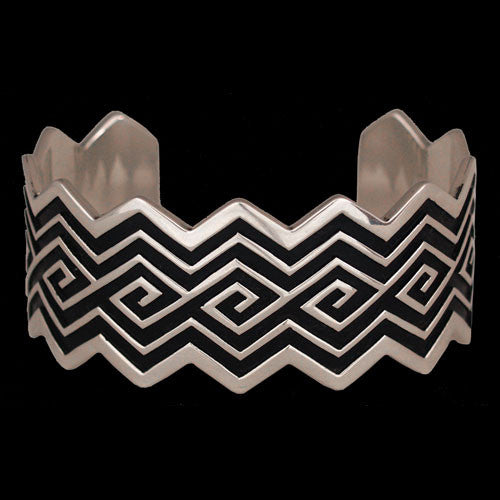
Navajo River Bracelet - Ray Scott (#04)
$950.00
Artist: Ray Scott
Navajo Jewelry
Total Circumference: 6 1/2"
Inner Circumference: 5 1/4"
Opening: 1 1/4"
Pooling, eddying, swirling water, that is what Ray Scott had in mind when he crafted this stunning sterling silver cuff. In the desert, water is sacred, and Ray’s bracelet exemplifies and celebrates this primary element. Ray is known for designing and executing clean and uncomplicated works of art and this is one is at once contemporary and timeless. Get it before the flood of calls start.
We offer a 100% satisfaction guarantee on every purchase.
Related legends:
Silversmith Work
When and how the Navajo acquired the art of working metals is unknown but there are reasons for supposing that it was introduced among them, or at least more developed and improved upon by them, since the time they have occupied their present country?
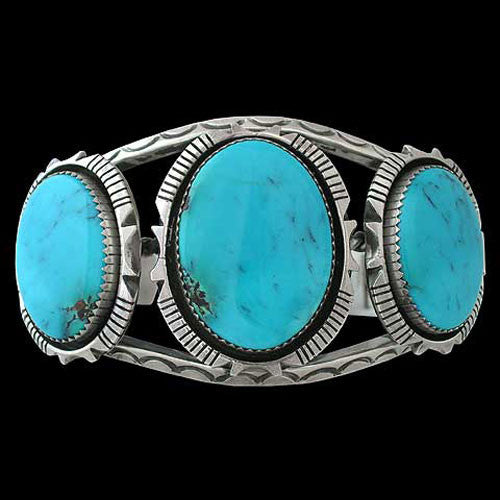
Navajo 3 Stone Blue Diamond Turquoise Bracelet - Toby Henderson (#048)
$950.00
Artist: Toby Henderson
Navajo Jewelry
Inner Circumference: 5 3/4"
Opening: 1"
Total: 6 3/4"
Width: 1 1/2"
From high upon a mountaintop in central Nevada comes this sky blue turquoise with the name of Blue Diamond. The Blue Diamond mine has the ability of producing a super high grade of natural turquoise and this bracelet possesses just that. Toby Henderson has a passion for top-notch turquoise and loves to set it in traditional styles of Navajo jewelry. Toby's hand stamped, carved and formed sterling silver setting beautifully accentuates the amazing nature of this turquoise. "Shazam!"
We offer a 100% satisfaction guarantee on every purchase.
About the artist:

Toby Henderson was born and raised in Phoenix, Arizona. The roots of his family tree are buried deep in the Borrego Pass area of the Navajo Reservation in New Mexico. Toby's mother Ella Long, his grandparents, Helen and Jim Long, and his Uncle Phillip Long, and Tommy Long are all silver and gold smiths recognized for high quality and innovative workmanship. Toby learned his art from his grandparents with whom he spent the summer months when he was a young boy. Toby recalls that his Grandparents were patient and inspiring instructors. They were pleased that he was carrying on the family silversmith tradition. Toby's work can be described as both traditional and contemporary, he has a special fondness for hand crafted, three-dimensional, sterling silver kachinas and Yei-be-chei figures. Toby was the first in his family to create these freestanding Holy People figures. With his daughters and son Toby keeps the family tradition alive. The boy and girls help with everything from design to buffing and polishing.
Related legends:
Silversmith Work
When and how the Navajo acquired the art of working metals is unknown but there are reasons for supposing that it was introduced among them, or at least more developed and improved upon by them, since the time they have occupied their present country?
